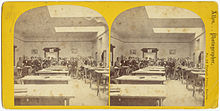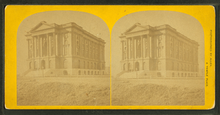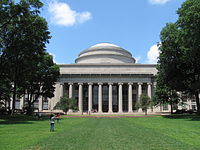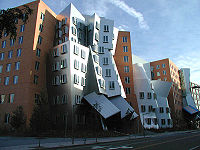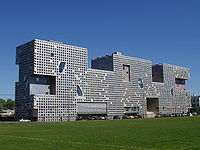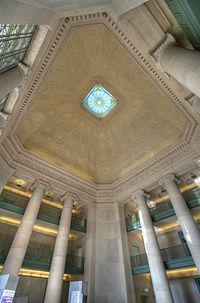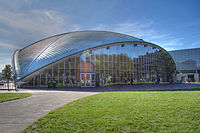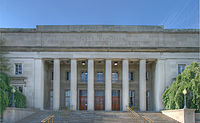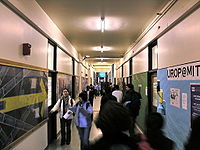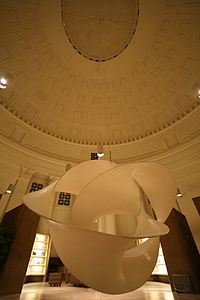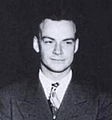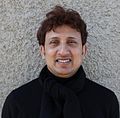- Massachusetts Institute of Technology
-
Massachusetts Institute of Technology 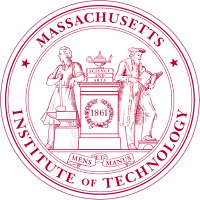
Motto Mens et Manus Motto in English Mind and Hand[1] Established 1861 (opened 1865) Type Private Endowment US$9.9 billion[2] President Susan Hockfield Provost L. Rafael Reif Academic staff 1,009[3] Students 10,384[4] Undergraduates 4,232[4] Postgraduates 6,152[4] Location Cambridge, Massachusetts, United States Campus Urban, 168 acres (68.0 ha)[5] Nobel Laureates 76[6] Colors Cardinal Red and Steel Gray[a] Athletics Division III (except for Rowing)
33 varsity teamsMascot Tim the Beaver[7] Affiliations NEASC, AAU, COFHE, NASULGC Website web.mit.edu The Massachusetts Institute of Technology (MIT) is a private research university located in Cambridge, Massachusetts. MIT has five schools and one college, containing a total of 32 academic departments, with a strong emphasis on scientific and technological education and research.
Founded in 1861 in response to the increasing industrialization of the United States, the institute adopted the European polytechnic university model and emphasized laboratory instruction from an early date.[8] MIT's early emphasis on applied technology at the undergraduate and graduate levels led to close cooperation with industry. Curricular reforms under Karl Compton and Vannevar Bush in the 1930s re-emphasized basic scientific research.[9] MIT was elected to the Association of American Universities in 1934. Researchers were involved in efforts to develop computers, radar, and inertial guidance in connection with defense research during World War II and the Cold War. Post-war defense research contributed to the rapid expansion of the faculty and campus under James Killian.
The current 168-acre (68.0 ha) campus opened in 1916 and extends over 1 mile (1.6 km) along the northern bank of the Charles River basin.[5] In the past 60 years, MIT's educational disciplines have expanded beyond the physical sciences and engineering into fields such as biology, economics, linguistics, political science, and management.
MIT enrolled 4,299 undergraduates and 6,267 graduate students for 2010–2011.[4] It employs around 1,000 faculty members.[3] 77 Nobel laureates, 50 National Medal of Science recipients, and 38 MacArthur Fellows are currently or have previously been affiliated with the university.[3][6]
MIT has a strong entrepreneurial culture. The aggregated revenues of companies founded by MIT alumni would rank as the eleventh-largest economy in the world.[10][11] MIT managed $718.2 million in research expenditures and an $8.0 billion endowment in 2009.[12][13]
The "Engineers"[14] sponsor 33 sports, most teams of which compete in the NCAA Division III's New England Women's and Men's Athletic Conference; the Division I rowing programs compete as part of the EARC and EAWRC.
Contents
History
Foundation and early years (1857–1917)
In 1859, the Massachusetts General Court was given a proposal for use of newly opened lands in Back Bay in Boston for a museum and Conservatory of Art and Science.[15] On April 10, 1861, the Governor of the Commonwealth of Massachusetts signed a charter for the incorporation of the "Massachusetts Institute of Technology and Boston Society of Natural History", submitted by William Barton Rogers. Rogers sought to establish a new form of higher education to address the challenges posed by rapid advances in science and technology during the mid-19th century with which classic institutions were ill-prepared to deal.[16][17] Barton believed, “The true and only practicable object of a polytechnic school is, as I conceive, the teaching, not of the minute details and manipulations of the arts, which can be done only in the workshop, but the inculcation of those scientific principles which form the basis and explanation of them, their leading processes and operations in connection with physical laws.”[18]
The Rogers Plan, as it has come to be known, reflected the German research university model, emphasizing an independent faculty engaged in research as well as instruction oriented around seminars and laboratories.[19] Rogers proposed that this new form of education be rooted in three principles: the educational value of useful knowledge, the necessity of “learning by doing”, and integrating a professional and liberal arts education at the undergraduate level.[20][21]
However, open conflict in the Civil War broke out on April 12, 1861, just two days after issuance of the charter. After years of delay caused by wartime funding and staffing difficulties, MIT's first classes were held in rented space at the Mercantile Building in downtown Boston in 1865.[22] Though it was to be located in the middle of urban Boston, the mission of the new institute matched the intent of the 1862 Morrill Land-Grant Colleges Act to fund institutions "to promote the liberal and practical education of the industrial classes." Although the Commonwealth of Massachusetts separately founded what was to become the University of Massachusetts under this act,[d] MIT was also named a land grant school.[23] The proceeds from land sales went toward new buildings in Boston's Back Bay neighborhood in 1866, and MIT informally came to be called "Boston Tech".[24]
During the next half-century, the focus of the science and engineering curriculum drifted towards vocational concerns instead of theoretical programs. During this period, the MIT faculty and alumni repeatedly rejected overtures from former MIT faculty turned Harvard University president Charles W. Eliot, to merge MIT with Harvard College's Lawrence Scientific School.[25]
Development and post-war growth (1916–1965)
“ ...a school of industrial science [aiding] the advancement, development and practical application of science in connection with arts, agriculture, manufactures, and commerce. ” —[26], Act to Incorporate the Massachusetts Institute of Technology, Acts of 1861, Chapter 183
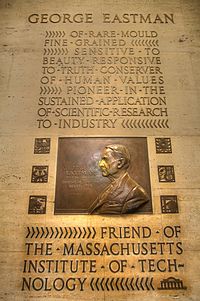 A plaque of George Eastman, founder of Eastman Kodak, in Building 6. His nose is rubbed by students for good luck.[27]
A plaque of George Eastman, founder of Eastman Kodak, in Building 6. His nose is rubbed by students for good luck.[27]
Industrialist George Eastman reinforced MIT's independence by donating funds to build a new campus along a mile-long tract on the Cambridge side of the Charles River, almost entirely on landfill.[28] In 1916, MIT moved into the handsome new neoclassical campus designed by William W. Bosworth.
In the 1930s, President Karl Taylor Compton and Vice-President (effectively Provost) Vannevar Bush drastically reformed the applied technology curriculum by re-emphasizing the importance of "pure" sciences like physics and chemistry and by reducing the vocational practice required in shops and drafting studios.[9] In sharp contrast to the Ivy League, MIT catered more to middle-class families, and depended more on tuition than on endowments or grants.[29] Despite the challenges of the Great Depression, the Compton reforms "renewed confidence in the ability of the Institute to develop leadership in science as well as in engineering."[20] The expansion and reforms cemented MIT's academic reputation[9] and the school was elected to the Association of American Universities in 1934.[30]
MIT was substantially changed by its involvement in military research during World War II. Vannevar Bush was appointed head of the enormous Office of Scientific Research and Development and directed funding to only a select group of universities, including MIT.[31][32] MIT's Radiation Laboratory was established in 1940 to assist the British military in developing a microwave radar, and the first mass-produced equipments were installed on front-line units within months. Other defense projects included gyroscope-based and other complex control systems for gun and bombsights and inertial navigation under Charles Stark Draper's Instrumentation Laboratory, the development of a digital computer for flight simulations under Project Whirlwind, and high-speed and high-altitude photography under Harold Edgerton.[33] By the end of the war, MIT employed a staff of over 4,000 (including more than a fifth of the nation's physicists) and was the nation's single largest wartime R&D contractor.[34]
In the post-war years, government-sponsored research such as SAGE and guidance systems for ballistic missiles and Project Apollo, combined with surging student enrollments under the G.I. Bill, contributed to rapid growth in the size of the Institute's research staff and physical plant, as well as placing an increased emphasis on graduate education.[20] The profound changes that occurred at MIT between 1930 and 1957 included the doubling of its faculty and a quintupling of its graduate student population. These changes were significantly guided and shaped by the institution-building strategies of Karl Taylor Compton, president of MIT between 1930 and 1948, James Rhyne Killian, president from 1948 to 1957, and Julius Adams Stratton, chancellor from 1952 to 1957.[35]
While the school mainly served the needs of industrial patrons in the 1920s, by the 1950s it had gained considerable autonomy from industrial corporations while attracting new patrons and building a close relationship with philanthropic foundations and the federal government. As the Cold War and Space Race intensified and concerns about the technology gap between the US and the Soviet Union grew more pervasive throughout the 1950s and 1960s, MIT's involvement in the military-industrial complex was a source of pride on campus.[36][37]
Recent history (1966–present)
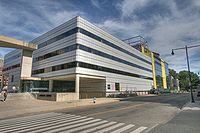 The MIT Media Lab houses researchers developing novel uses of computer technology. Shown here is the 1982 building, designed by I.M. Pei, with an extension (background) designed by Fumiko Maki and opened in March 2010.
The MIT Media Lab houses researchers developing novel uses of computer technology. Shown here is the 1982 building, designed by I.M. Pei, with an extension (background) designed by Fumiko Maki and opened in March 2010.
Following a comprehensive review of the undergraduate curriculum in 1949 and the successive appointments of more humanistically oriented Presidents Howard W. Johnson and Jerome Wiesner between 1966 and 1980, MIT greatly expanded its programs in the humanities, arts, and social sciences.[20][38] Previously marginalized faculties in the areas of economics, management, political science, and linguistics emerged into cohesive and assertive departments by attracting respected professors, launching competitive graduate programs, and forming into the School of Humanities, Arts, and Social Sciences and the MIT Sloan School of Management in 1950 to compete with the powerful Schools of Science and Engineering.[39][40]
In late 1960s and early 1970s, student and faculty activists protested against the Vietnam War and MIT's defense research.[41][42] The Union of Concerned Scientists was founded on March 4, 1969 during a meeting of faculty members and students seeking to shift the emphasis on military research towards environmental and social problems.[43] Although MIT ultimately divested itself from the Instrumentation Laboratory and moved all classified research off-campus to the Lincoln Laboratory facility in 1973 in response to the protests,[44][45] the student body, faculty, and administration remained comparatively unpolarized during the tumultuous era.[41][46]
In addition to developing the predecessors to modern computing and networking technologies,[47][48] students, staff, and faculty members at the Project MAC, Artificial Intelligence Laboratory, and Tech Model Railroad Club wrote some of the earliest interactive computer games like Spacewar! and created much of modern hacker slang.[49] Several major computer-related organizations have originated at MIT since the 1980s; Richard Stallman's GNU Project and the subsequent Free Software Foundation were founded in the mid-1980s at the AI Lab, the MIT Media Lab was founded in 1985 by Nicholas Negroponte and Jerome Wiesner to promote research into novel uses of computer technology,[50] the World Wide Web Consortium standards organization was founded at the Laboratory for Computer Science in 1994 by Tim Berners-Lee,[51] the OpenCourseWare project has made course materials for over 1,800 MIT classes available online free of charge since 2002,[52] and the One Laptop per Child initiative to expand computer education and connectivity to children worldwide was launched in 2005.[53] Upon taking office in 2004, President Hockfield launched an Energy Research Council to investigate how MIT can respond to the interdisciplinary challenges of increasing global energy consumption.[54]
MIT was named a sea-grant college in 1976 to support its programs in oceanography and marine sciences and was named a space-grant college in 1989 to support its aeronautics and astronautics programs.[55][56] Despite diminishing government financial support over the past quarter century, MIT launched several development campaigns to significantly expand the campus: new dormitories and athletics buildings on west campus, the Tang Center for Management Education, several buildings in the northeast corner of campus supporting research into biology, brain and cognitive sciences, genomics, biotechnology, and cancer research, and a number of new "backlot" buildings on Vassar Street including the Stata Center.[57] Construction on campus has recently[when?] concluded an expansion of the Media Lab, the Sloan's eastern campus, and graduate residences in the northwest.[58][59]
Campus
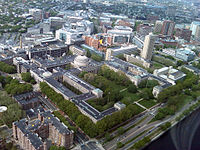 The central and eastern sections of MIT's campus as seen from above Massachusetts Avenue and the Charles River. In the center is the Great Dome overlooking Killian Court with Kendall Square in the background.
The central and eastern sections of MIT's campus as seen from above Massachusetts Avenue and the Charles River. In the center is the Great Dome overlooking Killian Court with Kendall Square in the background.
MIT's 168-acre (68.0 ha) campus spans approximately a mile of the north side of the Charles River basin in the city of Cambridge. The campus is divided roughly in half by Massachusetts Avenue, with most dormitories and student life facilities to the west and most academic buildings to the east. The bridge closest to MIT is the Harvard Bridge, which is known for being marked off in a non-standard unit of length – the smoot.[60][61] The Kendall MBTA Red Line station is located on the far northeastern edge of the campus in Kendall Square. The Cambridge neighborhoods surrounding MIT are a mixture of high tech companies occupying both modern office and rehabilitated industrial buildings as well as socio-economically diverse residential neighborhoods.[62]
MIT buildings all have a number (or a number and a letter) designation and most have a name as well.[63] Typically, academic and office buildings are referred to primarily by number while residence halls are referred to by name. The organization of building numbers roughly corresponds to the order in which the buildings were built and their location relative (north, west, and east) to the original, center cluster of Maclaurin buildings.[63] Many are connected above ground as well as through an extensive network of underground tunnels, providing protection from the Cambridge weather as well as a venue for roof and tunnel hacking.[64][65]
MIT's on-campus nuclear reactor is one of the largest university-based nuclear reactors in the United States.[66] The prominence of the reactor's containment building in a densely populated area has been controversial,[67] but MIT maintains that it is well-secured.[68] Other notable campus facilities include a pressurized wind tunnel and a towing tank for testing ship and ocean structure designs.[69][70] MIT's campus-wide wireless network was completed in the fall of 2005 and consists of nearly 3,000 access points covering 9,400,000 square feet (870,000 m2) of campus.[71]
In 2001, the Environmental Protection Agency sued MIT for violating Clean Water Act and Clean Air Act with regard to its hazardous waste storage and disposal procedures.[72] MIT settled the suit by paying a $155,000 fine and launching three environmental projects.[73] In connection with capital campaigns to expand the campus, the Institute has also extensively renovated existing buildings to improve their energy efficiency. MIT has also taken steps to reduce its environmental impact by running alternative fuel campus shuttles, subsidizing public transportation passes, and building a low-emission cogeneration plant that serves most of the campus electricity, heating, and cooling requirements.[74]
Between 2006 and 2008, MIT reported 16 forcible sex offenses, 4 robberies, 13 aggravated assaults, 536 burglaries, 2 cases of arson, and 16 cases of motor vehicle theft.[75]
Architecture
MIT's School of Architecture, now the School of Architecture and Planning, was the first in the United States,[76] and it has a history of commissioning progressive buildings.[77][78] The first buildings constructed on the Cambridge campus, completed in 1916, are known officially as the Maclaurin buildings after Institute president Richard Maclaurin who oversaw their construction. Designed by William Welles Bosworth, these imposing buildings were built of concrete, a first for a non-industrial — much less university — building in the US.[79] The utopian City Beautiful movement greatly influenced Bosworth's design, which features the Pantheon-esque Great Dome housing the Barker Engineering Library. The Great Dome overlooks Killian Court, where annual Commencement (graduation) exercises are held. The friezes of the limestone-clad buildings around Killian Court are engraved with the names of important scientists and philosophers.[k] The imposing Building 7 atrium along Massachusetts Avenue is regarded as the entrance to the Infinite Corridor and the rest of the campus.
Alvar Aalto's Baker House (1947), Eero Saarinen's Chapel and Auditorium (1955), and I.M. Pei's Green, Dreyfus, Landau, and Wiesner buildings represent high forms of post-war modernist architecture.[80][81][82] More recent buildings like Frank Gehry's Stata Center (2004), Steven Holl's Simmons Hall (2002), Charles Correa's Building 46 (2005), Fumihiko Maki's Media Lab Extension (2009) are distinctive amongst the Boston area's classical architecture and serve as examples of contemporary campus "starchitecture."[77][83] These buildings have not always been popularly acclaimed;[84][85] in 2010, The Princeton Review included MIT in a list of twenty schools whose campuses are "tiny, unsightly, or both."[86]
Housing
Undergraduates are guaranteed four-year housing in one of MIT's 12 undergrad dormitories, although 8% of students live off campus or commute.[87] On-campus housing provides live-in graduate student tutors and faculty housemasters who have the dual role of both helping students and monitoring them for medical or mental health problems. New undergrad students specify their dorm and floor preferences a few days after arrival on campus, and as a result diverse communities arise in living groups; e.g. the dorms on and east of Massachusetts Avenue have typically been more involved in countercultural activities.[88] MIT also has 5 dormitories for single graduate students and 2 apartment buildings on campus for married student families.[89]
MIT has a very active Greek and co-op system which includes 36 fraternities, sororities, and independent living groups (FSILGs).[90] 50% of male undergraduates join a fraternity and 34% of women join sororities.[91] Most FSILGs are located across the river in the Back Bay owing to MIT's historic location there, but eight fraternities are located on MIT's West Campus and in Cambridge. After the 1997 death of Scott Krueger, a new member at the Phi Gamma Delta fraternity, MIT required all freshmen to live in the dormitory system starting in 2002.[92] Because the fraternities and independent living groups had previously housed as many as 300 freshmen off-campus, the new policy did not take effect until 2002 after Simmons Hall opened.[93]
Organization and administration
MIT is chartered as a non-profit organization and is owned and governed by a privately appointed board of trustees known as the MIT Corporation.[94] The current board consists of 43 members elected to five year terms,[95] 25 life members who vote until their 75th birthday,[96] three elected officers (President, Treasurer, and Secretary),[97] and four ex officio members including the president of the alumni association, the Governor of Massachusetts, the Massachusetts Secretary of Education, and the Chief Justice of the Massachusetts Supreme Judicial Court.[98][99] The board is chaired by John S. Reed, the former chairman of the New York Stock Exchange and Citigroup.[100][101] The corporation approves the budget, new programs, degrees, and faculty appointments as well as electing the President to serve as the chief executive officer of the university and presiding over the Institute's faculty.[62][102] The sixteenth and current president, Susan Hockfield, a molecular neurobiologist, succeeded Charles M. Vest's fourteen year tenure in December 2004 and is the first woman to hold the post.[103] MIT's endowment and other financial assets are managed through a subsidiary MIT Investment Management Company (MITIMCo).[104] Valued at $8.0 billion in 2009, MIT's endowment is the sixth-largest among American colleges and universities.[12][105]
MIT is "a university polarized around science, engineering, and the arts."[106] It has five schools (Science, Engineering, Architecture and Planning, Management, and Humanities, Arts, and Social Sciences) and one college (Whitaker College of Health Sciences and Technology), but no schools of law or medicine.[107][e] The chair of each of MIT's 32 academic departments reports to the dean of that department's school, who in turn reports to the Provost under the President.[108] However, faculty committees assert substantial control over many areas of MIT's curriculum, research, student life, and administrative affairs.[109]
Collaborations
The university historically pioneered research and training collaborations between the academy, industry and government.[110][111] Fruitful collaborations with industrialists like Alfred P. Sloan and Thomas Alva Edison led President Compton to establish an Office of Corporate Relations and an Industrial Liaison Program in the 1930s and 1940s that now allows over 600 companies to license research and consult with MIT faculty and researchers.[9][112] Throughout the late 1980s and early 1990s, American politicians and business leaders accused MIT and other universities of contributing to a declining economy by transferring taxpayer-funded research and technology to international — especially Japanese — firms that were competing with struggling American businesses.[113][114]
MIT's extensive collaboration with the federal government on research projects has also led to several MIT leaders serving as Presidential scientific advisers since 1940.[j] MIT established a Washington Office in 1991 to continue to lobby for research funding and national science policy.[115][116] In response to MIT, eight Ivy League colleges, and 11 other institutions holding "Overlap Meetings" to prevent bidding wars over promising students from consuming funds for need-based scholarships, the Justice Department began an antitrust investigation in 1989 and in 1991 filed an antitrust suit against these universities.[117][118] While the Ivy League institutions settled,[119] MIT contested the charges on the grounds that the practice was not anti-competitive because it ensured the availability of aid for the greatest number of students.[120][121] MIT ultimately prevailed when the Justice Department dropped the case in 1994.[122][123]
MIT's proximity to Harvard University[i] has created both a quasi-friendly rivalry ("the other school up the river") and a substantial number of research collaborations such as the Harvard-MIT Division of Health Sciences and Technology and Broad Institute.[124][125] In addition, students at the two schools can cross-register for credits toward their own school's degrees without any additional fees.[125] A cross-registration program with Wellesley College has existed since 1969 and a significant undergraduate exchange program with the University of Cambridge known as the Cambridge-MIT Institute was also launched in 2002.[125] MIT has more modest cross-registration programs with Boston University, Brandeis University, Tufts University, Massachusetts College of Art, and the School of the Museum of Fine Arts, Boston.[125] MIT maintains substantial research and faculty ties with independent research organizations in the Boston-area like the Charles Stark Draper Laboratory, Whitehead Institute for Biomedical Research, and Woods Hole Oceanographic Institution as well as international research and educational collaborations through the Singapore-MIT Alliance, MIT-Politecnico di Milano,[125][126] MIT-Zaragoza International Logistics Program, and other countries through the MIT International Science and Technology Initiatives (MISTI) program.[125][127]
The mass-market magazine Technology Review is published by MIT through a subsidiary company, as is a special edition that also serves as the Institute's official alumni magazine. The MIT Press is a major university press, publishing over 200 books and 40 journals annually emphasizing science and technology as well as arts, architecture, new media, current events, and social issues.[128]
Academics
University rankings (overall) National Forbes[129] 5 U.S. News & World Report[130] 5 Washington Monthly[131] 11 Global ARWU[132] 3 QS[133] 3 Times[134] 3 MIT is a large, highly residential, research university with a majority of enrollments in graduate and professional programs.[135] The university has been accredited by the New England Association of Schools and Colleges since 1929.[136][137] MIT operates on a 4–1–4 academic calendar with the fall semester beginning after Labor Day and ending in mid-December, a 4-week "Independent Activities Period" in the month of January, and the spring semester beginning in early February and ending in late May.[138]
The School of Engineering has been ranked first among graduate and undergraduate programs by U.S. News & World Report since the first published results in 1994.[139][140] MIT has also consistently ranked first in the Academic Ranking of World Universities in Engineering/Technology and Computer Sciences.[141] A 1995 National Research Council study of US research universities ranked MIT first in "reputation" and fourth in "citations and faculty awards" and a 2005 NBER study of high school students' revealed preferences found MIT to be the 4th most preferred college in the nation.[142][143]
MIT students refer to both their majors and classes using numbers or acronyms alone.[144] Departments and their corresponding majors are numbered in the approximate order their foundation; for example, Civil and Environmental Engineering is Course I, while Nuclear Science & Engineering is Course XXII.[145][146] Students majoring in Electrical Engineering and Computer Science, the most popular department, collectively identify themselves as "Course VI." MIT students use a combination of the department's course number and the number assigned to the class to identify their subjects; the introductory calculus-based classical mechanics course is simply "8.01" at MIT.[f]
Undergraduate program
The four year, full-time undergraduate instructional program is classified as "balanced arts & sciences/professions" and admission is characterized as "more selective, lower transfer in."[135] MIT offers 44 undergraduate degrees across its five schools.[147] In 2009, some 1,146 bachelor of science (abbreviated as SB, from the Latin expression Scientiæ Baccalaureus) degrees were granted, the only type of undergraduate degree MIT now awards.[148][149] The School of Engineering is the most popular division, enrolling 44.5% of students in its 19 degree programs, followed by the School of Science (20.2%), School of Humanities, Arts, & Social Sciences (3.5%), Sloan School of Management (3.5%), and the School of Architecture and Planning (1.8%).[150] The largest undergraduate degree programs are in Electrical Engineering and Computer Science (Course VI-2), Mechanical Engineering (Course II), Computer Science and Engineering (Course VI-3), Physics (Course VIII), Biology (Course VII), and Mathematics (Course XVIII).[4]
Undergraduates are required to complete an extensive core curriculum called the General Institute Requirements (GIRs).[151] The science requirement, generally completed during freshman year as prerequisites for classes in science and engineering majors, comprises two semesters of physics, two semesters of calculus, one semester of chemistry, one semester of biology, and a laboratory class in their major. The humanities, arts, and social sciences (HASS) requirement, consisting of eight semesters, includes a distribution of three classes across each of the humanities, arts, and social sciences as well as a concentration. The communication requirement consists of two communication-intensive HASS classes and two classes in their major program. Finally, all students are required to complete a swimming test and non-varsity athletes must also take four physical education classes.[151]
Although the difficulty and especially the fast pace of MIT coursework has been characterized as "drinking from a fire hose,"[152] the freshmen retention rate at MIT is similar to other national research universities.[153] Some of the pressure for first-year undergraduates is lessened by the existence of the "pass/no-record" grading system. In the first (fall) term, freshmen transcripts only report if a class was passed while no external record exists if a class was not passed. In the second (spring) term, passing grades (ABC) appear on the transcript while non-passing grades are again rendered "no-record".[154] The system had previously been "Pass/No Record" all freshman year, but was amended for the Class of 2006 to prevent students from gaming the system by completing required major classes on a pass/fail basis.[155]
Most classes rely upon a combination of faculty led lectures, graduate student led recitations, weekly problem sets (p-sets), and tests to teach material, though alternative curricula exist, e.g. Experimental Study Group, Concourse, and Terrascope.[154] In recent years, there has been a trend towards "unified" mainstream introductory courses (e.g. in the Physics and the Electrical Engineering and Computer Science departments), incorporating a coordinated curriculum of theory and hands-on laboratory experiences.[citation needed]
In the past, some organized student groups have compiled "course bibles", collections of problem set and examination questions and answers used as references for later students. In 1970, the then-Dean of Institute Relations, Benson R. Snyder, published The Hidden Curriculum, arguing that unwritten regulations, like the implicit curricula of the bibles, are often counterproductive; they fool professors into believing that their teaching is effective and students into believing they have learned the material. For further coverage of this topic, see History of the Massachusetts Institute of Technology#Course "Bibles".
In 1969, MIT began the Undergraduate Research Opportunities Program (UROP) to enable undergraduates to collaborate directly with faculty members and researchers. The program, founded by Margaret MacVicar, builds upon the MIT philosophy of "learning by doing". Students join or initiate research projects, colloquially called "UROPs", through postings on the UROP website or by contacting faculty members directly.[156] Over 2,800 undergraduates, 70% of the student body, participate every year for academic credit, pay, or on a volunteer basis.[157] Students often become published, file patent applications, and/or launch start-up companies based upon their experience in UROPs.[158][159]
Graduate program
Robert Engman's Möbius Strip hangs from the crown of the Barker Engineering Library's reading room located inside the Great Dome
MIT's graduate program is a comprehensive doctoral program having high coexistence with undergraduate programs in the humanities, social sciences, and STEM fields as well as offering professional degrees.[135] The Institute offers graduate programs leading to academic degrees such as the Master of Science (SM), various Engineer's Degrees, Doctor of Philosophy (PhD), and Doctor of Science (ScD); professional degrees such as Master of Architecture (MArch),[160] Master of Business Administration (MBA),[161] Master of City Planning (MCP),[162] Master of Engineering (MEng),[163] and Master of Finance (MFin); and interdisciplinary graduate programs such as the MD/PhD (with Harvard Medical School).[164][165] Admission to graduate programs is decentralized; applicants apply directly to the department or degree program. Doctoral students are supported by fellowships (30%), research assistantships (49%), and teaching assistantships (13%).[166]
MIT awarded 1,474 master's degrees and 607 doctoral degrees in 2009.[148] The School of Engineering is the most popular academic division enrolling 45.4% of graduate students, followed by the Sloan School of Management (17.3%), School of Science (17.3%), School of Architecture and Planning (9.5%), School of Humanities, Arts, and Social Sciences (4.9%), and Whitaker College of Health Sciences (2.5%).[150] The largest graduate degree programs are the Sloan MBA, Electrical Engineering and Computer Science, Mechanical Engineering, and Chemical Engineering.[4]
Libraries, collections, and museums
The MIT library system consists of five subject libraries: Barker (Engineering), Dewey (Economics), Hayden (Humanities and Science), Lewis (Music), and Rotch (Arts and Architecture). There are also various specialized libraries and archives. The libraries contain more than 2.8 million printed volumes, 2.2 million microforms, 43,000 print or electronic journal subscriptions, and 570 databases.[167] Notable collections include the Lewis Music Library with an emphasis on 20th and 21st-century music and electronic music,[168] the List Visual Arts Center's rotating exhibitions of contemporary art,[169] and the Compton Gallery's cross-disciplinary exhibitions.[170] MIT allocates a percentage of the budget for all new construction and renovation to commission and support its extensive public art and outdoor sculpture collection.[171][172] The MIT Museum was founded in 1971 and collects, preserves, and exhibits artifacts significant to the life and history of MIT as well as collaborating with the nearby Museum of Science.[173]
Research
MIT was elected to the Association of American Universities in 1934 and remains a research university with a very high level of research activity;[30][135] research expenditures totaled $718.2 million in 2009.[13] The federal government was the largest source of sponsored research, with the Department of Health and Human Services granting $255.9 million, Department of Defense $97.5 million, Department of Energy $65.8 million, National Science Foundation $61.4 million, and NASA $27.4 million.[13] MIT employs approximately 1300 researchers in addition to faculty.[174] In 2009, MIT faculty and researchers disclosed 530 inventions, filed 184 patent applications, received 166 patents, and earned $136.3 million in royalties and other income.[175]
In electronics, magnetic core memory, radar, single electron transistors, and inertial guidance controls were invented or substantially developed by MIT researchers.[176][177] Harold Eugene Edgerton was a pioneer in high speed photography.[178] Claude E. Shannon developed much of modern information theory and discovered the application of Boolean logic to digital circuit design theory.[179] In the domain of computer science, MIT faculty and researchers made fundamental contributions to cybernetics, artificial intelligence, computer languages, machine learning, robotics, and cryptography.[177][180] At least nine Turing Award laureates and seven recipients of the Draper Prize in engineering have been or are currently associated with MIT.[181][182]
Current and previous physics faculty have won eight Nobel Prizes,[183] four Dirac Medals,[184] and three Wolf Prizes predominantly for their contributions to subatomic and quantum theory.[185] Members of the chemistry department have been awarded three Nobel Prizes and one Wolf Prize for the discovery of novel syntheses and methods.[183] MIT biologists have been awarded six Nobel Prizes for their contributions to genetics, immunology, oncology, and molecular biology.[183] Professor Eric Lander was one of the principal leaders of the Human Genome Project.[186][187] Positronium atoms,[188] synthetic penicillin,[189] synthetic self-replicating molecules,[190] and the genetic bases for Lou Gehrig's disease and Huntington's disease were first discovered at MIT.[191] Jerome Lettvin transformed the study of cognitive science with his paper "What the frog's eye tells the frog's brain".[192]
In the domain of humanities, arts, and social sciences, MIT economists have been awarded five Nobel Prizes and nine John Bates Clark Medals.[183][193] Linguists Noam Chomsky and Morris Halle authored seminal texts on generative grammar and phonology.[194][195] The MIT Media Lab, founded in 1985 within the School of Architecture and Planning and known for its unconventional research,[196][197] has been home to influential researchers such as constructivist educator and Logo creator Seymour Papert.[198]
Spanning many of the above fields, MacArthur Fellowships (the so-called "Genius Grants") have been awarded to 38 people associated with MIT.[199] Four Pulitzer Prize winning writers currently work at or have retired from MIT.[200] Four current or former faculty are members of the American Academy of Arts and Letters.[201]
Given MIT's prominence, allegations of research misconduct or improprieties have received substantial press coverage. Professor David Baltimore, a Nobel Laureate, became embroiled in a misconduct investigation starting in 1986 that led to Congressional hearings in 1991.[202][203] Professor Ted Postol has accused the MIT administration since 2000 of attempting to whitewash potential research misconduct at the Lincoln Lab facility involving a ballistic missile defense test, though a final investigation into the matter has not been completed.[204][205] Associate Professor Luk Van Parijs was dismissed in 2005 following allegations of scientific misconduct and found guilty of the same by the United States Office of Research Integrity in 2009.[206][207]
Traditions and student activities
The faculty and student body highly value meritocracy and technical proficiency.[208][209] MIT has never awarded an honorary degree, nor does it award athletic scholarships, ad eundem degrees, or Latin honors upon graduation.[210] However, MIT has twice awarded honorary professorships; to Winston Churchill in 1949 and Salman Rushdie in 1993.[211]
Many upperclass students and alumni wear a large, heavy, distinctive class ring known as the "Brass Rat".[212][213] Originally created in 1929, the ring's official name is the "Standard Technology Ring."[214] The undergraduate ring design (a separate graduate student version exists as well) varies slightly from year to year to reflect the unique character of the MIT experience for that class, but always features a three-piece design, with the MIT seal and the class year each appearing on a separate face, flanking a large rectangular bezel bearing an image of a beaver.[212] The initialism IHTFP, representing the informal school motto "I Hate This Fucking Place" and jocularly euphemized as "I Have Truly Found Paradise," "Institute Has The Finest Professors," "It's Hard to Fondle Penguins," and other variations, has occasionally been featured on the ring given its historical prominence in student culture.[215]
Activities
Main article: Student activities at MITMIT has over 380 recognized student activity groups,[216] including a campus radio station, The Tech student newspaper, an annual entrepreneurship competition, and weekly screenings of popular films by the Lecture Series Committee. Less traditional activities include the "world's largest open-shelf collection of science fiction" in English, a model railroad club, and a vibrant folk dance scene. Students, faculty, and staff are involved in over 50 educational outreach and public service programs through the MIT Museum, Edgerton Center, and MIT Public Service Center.[217]
The Independent Activities Period is a four-week long "term" offering hundreds of optional classes, lectures, demonstrations, and other activities throughout the month of January between the Fall and Spring semesters. Some of the most popular recurring IAP activities are the 6.270, 6.370, and MasLab competitions,[218] the annual "mystery hunt",[219] and Charm School.[220][221] Students also have the opportunity of pursuing externships at companies in the US and abroad.
Many MIT students also engage in "hacking," which encompasses both the physical exploration of areas that are generally off-limits (such as rooftops and steam tunnels), as well as elaborate practical jokes.[222][223] Recent high-profile hacks have included the theft of Caltech's cannon,[224] reconstructing a Wright Flyer atop the Great Dome,[225] and adorning the John Harvard statue with the Master Chief's Spartan Helmet.[226]
Athletics
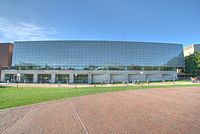 The Zesiger sports and fitness center houses a two-story fitness center as well as swimming and diving pools
The Zesiger sports and fitness center houses a two-story fitness center as well as swimming and diving pools
The student athletics program offers 33 varsity-level sports, which makes it one of the largest programs in the US[227][228] MIT participates in the NCAA's Division III, the New England Women's and Men's Athletic Conference, the New England Football Conference, the Pilgrim League for men's lacrosse and NCAA's Division I Eastern Association of Rowing Colleges (EARC) for crew. In April 2009, budget cuts lead to MIT eliminating eight of its 41 sports, including the mixed men’s and women’s teams in alpine skiing and pistol; separate teams for men and women in ice hockey and gymnastics; and men’s programs in golf and wrestling.[229][230][231]
The Institute's sports teams are called the Engineers, their mascot since 1914 being a beaver, "nature's engineer." Lester Gardner, a member of the Class of 1898, provided the following justification:
The beaver not only typifies the Tech, but his habits are particularly our own. The beaver is noted for his engineering and mechanical skills and habits of industry. His habits are nocturnal. He does his best work in the dark.[232]
MIT fielded several dominant intercollegiate Tiddlywinks teams through 1980, winning national and world championships.[233] The Engineers have won or placed highly in national championships in pistol, taekwondo, track and field, swimming and diving, cross country, crew, fencing, and water polo.[citation needed] MIT has produced 128 Academic All-Americans, the third largest membership in the country for any division and the highest number of members for Division III.[227]
The Zesiger sports and fitness center (Z-Center) which opened in 2002, significantly expanded the capacity and quality of MIT's athletics, physical education, and recreation offerings to 10 buildings and 26 acres (110,000 m2) of playing fields.[citation needed] The 124,000-square-foot (11,500 m2) facility features an Olympic-class swimming pool, international-scale squash courts, and a two-story fitness center.[227]
People
Students
Demographics of MIT student body[4][234] Undergraduate Graduate Caucasian American 42.5% 40.8% Asian American 25.6% 9.4% Hispanic American 13.2% 3.3% African American 8.5% 2.1% Native American 1.0% 0.4% Other/International 9.2% 44.0% MIT enrolled 4,232 undergraduates and 6,152 graduate students in 2009–2010.[4] Women constituted 45.3 percent of undergraduates and 31.1 percent of graduate students.[4][235] Undergraduate and graduate students are drawn from all 50 states as well as 118 foreign countries.[236]
MIT received 15,661 applications for admission to the Class of 2014; 1675 were admitted (10.7 percent) and 1078 enrolled (63.9 percent).[91] 19,446 applications were received for advanced degree program across all departments; 2,991 were admitted (15.4 percent) and 1,880 enrolled (62.8 percent).[237] The interquartile range on the SAT was 2030–2320 and 95 percent of students ranked in the top tenth of their high school graduating class.[91] 97 percent of the Class of 2012 returned as sophomores; 82.3 percent of the Class of 2007 graduated within 4 years, and 91.3 percent (92 percent of the men and 96 percent of the women) graduated within 6 years.[91][238]
Undergraduate tuition and fees total $37,782 and annual expenses are estimated at $50,100. 61 percent of students received need-based financial aid in the form of scholarships and grants from federal, state, institutional, and external sources averaging $35,202 per student.[239] MIT awarded $87.6 million in scholarships and grants, the vast majority ($73.4 million) coming from institutional support.[91] The annual increase in expenses has led to a student tradition (dating back to the 1960s) of tongue-in-cheek "tuition riots".[240]
MIT has been nominally coeducational since admitting Ellen Swallow Richards in 1870. Richards also became the first female member of MIT's faculty, specializing in sanitary chemistry.[241] Female students remained a very small minority (less than 3 percent) prior to the completion of the first wing of a women's dormitory, McCormick Hall, in 1962.[242][243] Between 1993 and 2009, the proportion of women rose from 34 percent to 45 percent of undergraduates and from 20 percent to 31 percent of graduate students.[4][244] Women currently outnumber men in Biology, Brain & Cognitive Sciences, Architecture, Urban Planning, and Biological Engineering.[4][235]
A number of student deaths in the late 1990s and early 2000s resulted in considerable media attention to MIT's culture and student life.[245][246] After the alcohol-related death of Scott Krueger in September 1997 as a new member at the Phi Gamma Delta fraternity,[247] MIT began requiring all freshmen to live in the dormitory system.[247][248] The 2000 suicide of MIT undergraduate Elizabeth Shin drew attention to suicides at MIT and created a controversy over whether MIT had an unusually high suicide rate.[249][250] In late 2001 a task force's recommended improvements in student mental health services were implemented,[251][252] including expanding staff and operating hours at the mental health center.[253] These and later cases were significant as well because they sought to prove the negligence and liability of university administrators in loco parentis.[249]
Faculty
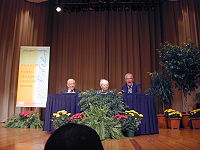 Institute Professors Emeriti and Nobel Laureates (from left to right) Franco Modigliani (now deceased), Paul Samuelson (also deceased), and Robert Solow
Institute Professors Emeriti and Nobel Laureates (from left to right) Franco Modigliani (now deceased), Paul Samuelson (also deceased), and Robert Solow
MIT has 1,010 faculty members, of whom 198 are women.[3] Faculty are responsible for lecturing classes, advising both graduate and undergraduate students, and sitting on academic committees, as well as conducting original research. Between 1964 and 2009, a total of 17 faculty and staff members affiliated with MIT were awarded Nobel Prizes (14 during the last quarter century, 13 the last 25 years).[254] MIT faculty members past or present have won a total of 27 Nobel Prizes, the majority in Economics or Physics.[255] Among current faculty and teaching staff, there are 80 Guggenheim Fellows, 6 Fulbright Scholars, and 29 MacArthur Fellows.[3] Faculty members who have made extraordinary contributions to their research field as well as the MIT community are granted appointments as Institute Professors for the remainder of their tenures.
A 1998 MIT study concluded that a systemic bias against female faculty existed in its college of science,[256] although the study's methods were controversial.[257][258] Since the study, though, women have headed departments within the Schools of Science and Engineering, and MIT has appointed several female vice presidents, although allegations of sexism continue to be made.[259] Susan Hockfield, a molecular neurobiologist, became MIT's 16th president in 2004 and is the first woman to hold the post.
Tenure outcomes have vaulted MIT into the national spotlight on several occasions. The 1984 dismissal of David F. Noble, a historian of technology, became a cause célèbre about the extent to which academics are granted freedom of speech after he published several books and papers critical of MIT's and other research universities' reliance upon financial support from corporations and the military.[260] Former materials science professor Gretchen Kalonji sued MIT in 1994 alleging that she was denied tenure because of sexual discrimination.[259][261] In 1997, the Massachusetts Commission Against Discrimination issued a probable cause finding supporting James Jennings' allegations of racial discrimination after a senior faculty search committee in the Department of Urban Studies and Planning did not offer him reciprocal tenure.[262] In 2006–2007, MIT's denial of tenure to African-American biological engineering professor James Sherley reignited accusations of racism in the tenure process, eventually leading to a protracted public dispute with the administration, a brief hunger strike, and the resignation of Professor Frank L. Douglas in protest.[263][264]
MIT faculty members have often been recruited to lead other colleges and universities; former Provost Robert A. Brown is President of Boston University, former Provost Mark Wrighton is Chancellor of Washington University in St. Louis, former Associate Provost Alice Gast is president of Lehigh University, former Dean of the School of Science Robert J. Birgeneau is the Chancellor of the University of California, Berkeley, and former professor David Baltimore had been President of Caltech. In addition, faculty members have been recruited to lead governmental agencies; for example, former professor Marcia McNutt is the director of the United States Geological Survey,[265] urban studies professor Xavier de Souza Briggs is currently the associate director of the White House Office of Management and Budget,[266] and biology professor Eric Lander is a co-chair of the President's Council of Advisors on Science and Technology.[267]
Alumni
Many of MIT's over 120,000 alumni and alumnae have had considerable success in scientific research, public service, education, and business. As of 2011, twenty-four MIT alumni have won the Nobel Prize, forty-four have been selected as Rhodes Scholars, and fifty-five have been selected as Marshall Scholars.[268]
Alumni in American politics and public service include Chairman of the Federal Reserve Ben Bernanke, MA-1 Representative John Olver, CA-13 Representative Pete Stark, former National Economic Council chairman Lawrence H. Summers, and former Council of Economic Advisors chairwoman Christina Romer. MIT alumni in international politics include former British Foreign Minister David Miliband, Israeli Prime Minister Benjamin Netanyahu, Greek Prime Minister Lucas Papademos, former UN Secretary General Kofi Annan, physicist Richard Feynman, and former Iraqi Deputy Prime Minister Ahmed Chalabi.
MIT alumni founded or co-founded many notable companies, such as Intel, McDonnell Douglas, Texas Instruments, 3Com, Qualcomm, Bose, Raytheon, Koch Industries, Rockwell International, Genentech, and Campbell Soup. According to the British newspaper, The Guardian, "a survey of living MIT alumni found that they have formed 25,800 companies, employing more than three million people including about a quarter of the workforce of Silicon Valley. Those firms between them generate global revenues of about $1.9tn (£1.2tn) a year. If MIT was a country, it would have the 11th highest GDP of any nation in the world."[269] MIT managed $718.2 million in research expenditures and an $8.0 billion endowment in 2009.[12][13]
Prominent institutions of higher education have been led by MIT alumni, including the University of California system, Harvard University, Johns Hopkins University, Carnegie Mellon University, Tufts University, Rochester Institute of Technology, Rhode Island School of Design (RISD), Northeastern University, Lahore University of Management Sciences, Rensselaer Polytechnic Institute, Tecnológico de Monterrey, Purdue University, Virginia Polytechnic Institute and Quaid-e-Azam University.
More than one third of the United States' manned spaceflights have included MIT-educated astronauts (among them Apollo 11 Lunar Module Pilot Buzz Aldrin), more than any university excluding the United States service academies.[270]
Noted alumni in non-scientific fields include author Hugh Lofting,[271] sculptor Daniel Chester French, Boston guitarist Tom Scholz, The New York Times columnist and Nobel Prize Winning economist Paul Krugman, The Bell Curve author Charles Murray, United States Supreme Court building architect Cass Gilbert, Pritzker Prize-winning architects I.M. Pei and Gordon Bunshaft.
-
Apollo 11 astronaut Buzz Aldrin, ScD 1963 (Course XVI)
-
Former UN Secretary-General Kofi Annan, SM 1972 (Course XV)
-
Federal Reserve Bank Chairman Ben Bernanke, PhD 1979 (Course XIV)
-
Physicist Nobel laureate Richard Feynman, SB 1939 (Course VIII)
-
Economics Nobel laureate Paul Krugman, PhD 1977 (Course XIV)
-
Israeli Prime Minister Benjamin Netanyahu, SB '75 (Course IV), SM 1976 (Course XV)
-
Intel co-founder Robert Noyce, PhD 1953 (Course VIII)
-
Architect I. M. Pei, BArch 1940 (Course IV)
Notes
Footnotes
- a. ^ "We looked up and discussed many colors. We all desired cardinal red; it has stood for a thousand years on land and sea in England's emblem; it makes one-half of the stripes on America's flag; it has always stirred the heart and mind of man; it stands for 'red blood' and all that 'red blood' stands for in life. But we were not unanimous for the gray; some wanted blue, I recall. But it (the gray) seemed to me to stand for those quiet virtues of modesty and persistency and gentleness, which appealed to my mind as powerful; and I have come to believe, from observation and experience, to really be the most lasting influences in life and history....We recommended 'cardinal and steel gray.'" (Alfred T. Waite, Chairman of School Color Committee, Class of 1879)[272]
- b. ^ The other privately owned Land Grant institution is Cornell University.
- d. ^ The University of Massachusetts was founded as the Massachusetts Agricultural College in 1863.
- e. ^ The Harvard-MIT Division of Health Sciences and Technology (HST) offers joint MD, MD-PhD, or Medical Engineering degrees in collaboration with Harvard Medical School.[273]
- f. ^ Course numbers are traditionally presented in Roman numerals, e.g. Course XVIII for mathematics. Starting in 2002, the Bulletin (MIT's course catalog) started to use Arabic numerals. Usage outside of the Bulletin varies, both Roman and Arabic numerals being used.[274]
- h. ^ MIT's Building 7 and Harvard's Johnston Gate, the traditional entrances to each school, are 1.72 miles (2.77 km) apart along Massachusetts Avenue.
- i. ^ Vannevar Bush was the director of the Office of Scientific Research and Development and general advisor to Franklin D. Roosevelt and Harry Truman, James Rhyne Killian was Special Assistant for Science and Technology for Dwight D. Eisenhower, and Jerome Wiesner advised John F. Kennedy and Lyndon Johnson.[275]
- j. ^ The friezes of the marble-clad buildings surrounding Killian Court are carved in large Roman letters with the names of Aristotle, Newton, Pasteur, Lavoisier, Faraday, Archimedes, da Vinci, Darwin, and Copernicus; each of these names is surmounted by a cluster of appropriately related names in smaller letters. Lavoisier, for example, is placed in the company of Boyle, Cavendish, Priestley, Dalton, Gay Lussac, Berzelius, Woehler, Liebig, Bunsen, Mendelejeff [sic], Perkin, and van't Hoff.[276]
Citations
- ^ "Symbols: Seal". MIT Graphic Identity. MIT. http://web.mit.edu/graphicidentity/symbols/seal.html. Retrieved 2010-09-08.
- ^ "MIT releases endowment figures for 2011". MIT News Office. MIT. http://web.mit.edu/newsoffice/2011/endowment-0926.html. Retrieved 2011-09-27.
- ^ a b c d e <Please add first missing authors to populate metadata.> (2009, January). "MIT facts 2009: Faculty and staff". MIT Bulletin 144 (4). http://web.mit.edu/facts/faculty.html.
- ^ a b c d e f g h i j k MIT, Office of the Registrar. (9 October 2009). "Enrollment statistics: Fall term 2009–2010". http://web.mit.edu/registrar/stats/yrpts/index.html. Retrieved 8 September 2010.
- ^ a b "MIT Facts: The Campus". MIT. 2010. http://web.mit.edu/facts/campus.html. Retrieved 8 September 2010.
- ^ a b "Awards and Honors". Institutional Research, Office of the Provost. http://web.mit.edu/ir/pop/awards/nobel.html. Retrieved 18 Octoboer 2011.
- ^ "Symbols: Mascot". MIT Graphic Identity. MIT. http://web.mit.edu/graphicidentity/symbols/mascot.html. Retrieved 2010-09-08.
- ^ Angulo, A.J.. William Barton Rogers and the Idea of MIT. The Johns Hopkins University Press. pp. 155–156. ISBN 0801890330.
- ^ a b c d Lecuyer, Christophe (1992). "The making of a science based technological university: Karl Compton, James Killian, and the reform of MIT, 1930–1957". Historical Studies in the Physical and Biological Sciences 23 (1): 153–180.
- ^ Ericka Chickowski (September 20, 2010). "Gurus and Grads". Entrepreneur. http://www.entrepreneur.com/article/217327.
- ^ "Kauffman Foundation study finds MIT alumni companies generate billions for regional economies". MIT News Office. February 17, 2009. http://web.mit.edu/newsoffice/2009/kauffman-study-0217.html. Retrieved 2009-02-25.
- ^ a b c "MIT releases 2010 endowment figures". 27 September 2010. http://web.mit.edu/press/2010/endowment-0927.html.
- ^ a b c d "MIT Facts: Research at MIT". MIT. 2010. http://web.mit.edu/facts/research.html. Retrieved September 7, 2010.
- ^ "Top 10 Worst Team Names". Time magazine. July 4, 2011. http://www.time.com/time/specials/packages/article/0,28804,1898998_1898997_1898987,00.html.
- ^ Kneeland, Samuel (March 1859). "Committee Report:Conservatory of Art and Science" (PDF). Massachusetts House of Representatives, House No. 260. http://libraries.mit.edu/archives/mithistory/pdf/house260.pdf.
- ^ "MIT Facts 2008: Mission and Origins". MIT. http://web.mit.edu/facts/mission.shtml. Retrieved 2008-08-14.
- ^ Rogers, William (1861). "Objects and Plan of an Institute of Technology: including a Society of Arts, a Museum of Arts, and a School of Industrial Science; proposed to be established in Boston" (PDF). The Committee of Associated Institutions of Science and Arts. http://libraries.mit.edu/archives/mithistory/pdf/objects-plan.pdf.
- ^ "Letter from William Barton Rogers to His Brother Henry". Institute Archives, MIT. March 13, 1846. http://libraries.mit.edu/archives/timeline/letter1846.html. Retrieved October 2, 2010.
- ^ Angulo, A.J.. "The Initial Reception of MIT, 1860s–1880s". In Geiger, Roger L.. Perspectives on the History of Higher Education. pp. 1–28.
- ^ a b c d Lewis, Warren K., Ronald H. Robnett, C. Richard Soderberg, Julius A. Stratton et al. (1949) (PDF). Report of the Committee on Educational Survey (Lewis Report). Cambridge, Massachusetts: MIT Press. p. 8. http://libraries.mit.edu/archives/mithistory/pdf/lewis.pdf. Retrieved 2006-10-04.
- ^ "The Founding of MIT". MIT Archives. http://libraries.mit.edu/archives/exhibits/MIT-birthday/index1.html. Retrieved 2008-08-12. "Barton's philosophy for the institute was for 'the teaching, not of the manipulations done only in the workshop, but the inculcation of all the scientific principles which form the basis and explanation of them;'"
- ^ Andrews, Elizabeth; Nora Murphy and Tom Rosko (2000). "William Barton Rogers: MIT's Visionary Founder". MIT Archives. http://libraries.mit.edu/archives/exhibits/wbr-visionary/.
- ^ Stratton, Julius Adams; Mannix, Loretta H. (2005). "The Land-Grant Act of 1862". Mind and Hand: The Birth of MIT. MIT Press. pp. 251–276. ISBN 0262195240.
- ^ Prescott, Samuel C (1954). When M.I.T. Was "Boston Tech", 1861–1916. MIT Press.
- ^ "Alumni Petition Opposing MIT-Harvard Merger, 1904–05". Institute Archives, MIT. http://libraries.mit.edu/archives/exhibits/harvard-mit/index.html. Retrieved October 1, 2010.
- ^ "Charter of the MIT Corporation". http://web.mit.edu/corporation/charter.html. Retrieved 2007-03-22.
- ^ "Students hope 'Eastman moment' proves lucky as they head into final exams". MIT News Office. 22 May 2002. http://web.mit.edu/newsoffice/2002/eastman-0522.html. Retrieved 12 Mary 2008.
- ^ J. B. Shields (1852). Middlesex Canal (Massachusetts) map, 1852 (Map). http://en.wikipedia.org/wiki/File:Middlesex_Canal_%28Massachusetts%29_map,_1852.jpg. Retrieved 2010-09-17.
- ^ Geiger, Roger L. (2004). To advance knowledge: the growth of American research universities, 1900–1940. pp. 13–15, 179–9. ISBN 0195038037.
- ^ a b "Member Institutions and Years of Admission". Association of American Universities. http://www.aau.edu/aau/members.html. Retrieved 14 August 2008.
- ^ Leslie, Stuart (1993). The Cold War and American Science: The Military-Industrial-Academic Complex at MIT and Stanford. Columbia University Press. ISBN 0-231-07959-1.
- ^ Zachary, Gregg (1997). Endless Frontier: Vannevar Bush, Engineer of the American Century. Free Press. ISBN 0-684-82821-9.
- ^ "Wartime Strobe: 1939–1945 – Harold "Doc" Edgerton". http://edgerton-digital-collections.org/docs-life/wartime-strobe. Retrieved 28 November 2009.
- ^ "MIT's Rad Lab". IEEE Global History Network. http://www.ieeeghn.org/wiki/index.php/MIT_Rad_Lab. Retrieved 25 July 2008.
- ^ Lecuyer, 1992
- ^ "More Emphasis on Science Vitally Needed to Educate Man for A Confused Civilization" (PDF). The Tech. February 14, 1958. http://tech.mit.edu/archives/VOL_078/TECH_V078_S0008_P001.pdf. Retrieved 5 November 2006.
- ^ "Iron Birds Caged in Building 7 Lobby: Missiles on Display Here" (PDF). The Tech. February 25, 1958. http://tech.mit.edu/archives/VOL_078/TECH_V078_S0030_P001.pdf. Retrieved 5 November 2006.
- ^ Johnson, Howard Wesley (2001). Holding the Center: Memoirs of a Life in Higher Education. MIT Press. ISBN 0262600447. http://www.google.com/books?id=9qpmDJQPEZEC&printsec=frontcover.
- ^ "History: School of Humanities, Arts, and Social Sciences". MIT Archives. Archived from the original on 2010-03-11. http://web.archive.org/web/20100311064018/http://libraries.mit.edu/archives/mithistory/histories-offices/sch-hum.html. Retrieved 2008-07-25.
- ^ "History: Sloan School of Management". MIT Archives. Archived from the original on 2010-06-21. http://web.archive.org/web/20100621002719/http://libraries.mit.edu/archives/mithistory/histories-offices/sch-sloan.html. Retrieved 2008-07-25.
- ^ a b Todd, Richard (May 18, 1969). "The 'Ins' and 'Outs' at M.I.T". The New York Times.
- ^ <Please add first missing authors to populate metadata.> (February 28, 1969). "A Policy of Protest". Time. http://www.time.com/time/magazine/article/0,9171,900700,00.html. Retrieved 2008-08-13.
- ^ "Founding Document: 1968 MIT Faculty Statement". Union of Concerned Scientists, USA. Archived from the original on January 15, 2008. http://web.archive.org/web/20080115200053/http://www.ucsusa.org/ucs/about/founding-document-1968-mit-faculty-statement.html. Retrieved 2008-08-12.
- ^ Hechinger, Fred (November 9, 1969). "Tension Over Issue Of Defense Research". The New York Times.
- ^ Stevens, William (May 5, 1969). "MIT Curb on Secret Projects Reflects Growing Antimilitary Feeling Among Universities' Researchers". The New York Times.
- ^ Warsh, David (June 1, 1999). "A tribute to MIT's Howard Johnson". The Boston Globe. http://web.mit.edu/newsoffice/1999/johnson-0609.html. Retrieved 2007-04-04. "At a critical time in the late 1960s, Johnson stood up to the forces of campus rebellion at MIT. Many university presidents were destroyed by the troubles. Only Edward Levi, University of Chicago president, had comparable success guiding his institution to a position of greater strength and unity after the turmoil."
- ^ <Please add first missing authors to populate metadata.>; Lee, J; McCarthy, J; Licklider, J (1992) (PDF). The beginnings at MIT. 14. IEEE Annals of the History of Computing. http://ieeexplore.ieee.org/iel4/85/3898/00145317.pdf. Retrieved 2008-08-13.
- ^ "Internet History". Computer History Museum. http://www.computerhistory.org/internet_history/. Retrieved 2008-08-13.
- ^ Raymond, Eric S.. "A Brief History of Hackerdom". http://www.catb.org/~esr/writings/cathedral-bazaar/hacker-history/ar01s02.html. Retrieved 2008-08-11.
- ^ "The Media Lab – Retrospective". MIT Media Lab. Archived from the original on 2009-04-17. http://web.archive.org/web/20090417085247/http://media.mit.edu/?page_id=16. Retrieved 2008-08-12.
- ^ "About W3C: History". World Wide Web Consortium. http://www.w3.org/Consortium/facts#history. Retrieved 2008-08-11.
- ^ "MIT OpenCourseWare". MIT. http://ocw.mit.edu/. Retrieved 2008-06-12.
- ^ "Mission – One Laptop Per Child". One Laptop Per Child. http://www.laptop.org/en/vision/mission/. Retrieved 2008-08-11.
- ^ "Energy Research Council homepage". MIT. http://web.mit.edu/mitei/. Retrieved 2006-10-24.
- ^ "Massachusetts Space Grant Consortium". Massachusetts Space Grant Consortium. http://web.mit.edu/masgc/www/index.shtml. Retrieved 2008-08-26.
- ^ "MIT Sea Grant College Program". MIT Sea Grant College Program. Archived from the original on 2009-04-09. http://web.archive.org/web/20090404013114/http://seagrant.mit.edu/about_us/index.php. Retrieved 2008-08-26.
- ^ Simha., O. R. (2003). MIT campus planning 1960–2000: An annotated chronology. MIT Press. pp. 120–149. ISBN 978-0-262-69294-6. http://books.google.com/?id=ldq-ZgxszzMC&lpg=PA120&pg=PA120.
- ^ "MIT Facilities: In Development & Construction". MIT. Archived from the original on 2009-03-12. http://web.archive.org/web/20090312070340/http://web.mit.edu/facilities/construction/ki/index.html. Retrieved 2008-07-22.
- ^ Bombardieri, Marcella (September 14, 2006). "MIT will accelerate its building boom: $750m expansion to add 4 facilities". The Boston Globe. http://www.boston.com/news/nation/articles/2006/09/14/mit_will_accelerate_its_building_boom/. Retrieved 2008-08-13.
- ^ Durant, Elizabeth. "Smoot's Legacy: 50th anniversary of famous feat nears". Technology Review. http://www.technologyreview.com/article/20983/. Retrieved 2008-08-13.
- ^ Fahrenthold, David (8 December 2005). "The Measure of This Man Is in the Smoot; MIT's Human Yardstick Honored for Work". The Washington Post.
- ^ a b "MIT Course Catalogue: Overview". MIT. http://web.mit.edu/catalog/overv.chap1.html. Retrieved July 16, 2008.
- ^ a b "Building History and Numbering System". Mind and Hand Book, MIT. http://studentlife.mit.edu/mindandhandbook/campus-life/building-history. Retrieved 13 August 2008.
- ^ "MIT Campus Subterranean Map" (PDF). MIT Department of Facilities. Archived from the original on 2010-07-31. http://web.archive.org/web/20100731034447/http://mit.edu/facilities/maps/tunnelMap.pdf. Retrieved 2008-08-13.
- ^ Abel, David (March 30, 2000). "'Hackers' Skirt Security in Late-Night MIT Treks". The Boston Globe.
- ^ "MIT Course Catalog". MIT. Archived from the original on 2009-01-04. http://web.archive.org/web/20090104182125/http://web.mit.edu/catalogue/overv.chap6-nrl.shtml. Retrieved July 14, 2008.
- ^ "Loose Nukes: A Special Report". ABC News. http://abcnews.go.com/Technology/LooseNukes/. Retrieved April 14, 2007.
- ^ "MIT Assures Community of Research Reactor Safety". MIT News Office. October 13, 2005. http://web.mit.edu/newsoffice/2005/reactor.html. Retrieved October 5, 2006.
- ^ "Supersonic Tunnel Open; Naval Laboratory for Aircraft Dedicated at M.I.T". The New York Times. December 2, 1949.
- ^ "Ship Test Tank for M.I.T.; Dr. Killian Announces Plant to Cost $500,000". The New York Times. February 6, 1949.
- ^ "MIT maps wireless users across campus". MIT. 2005-11-04. Archived from the original on September 5, 2006. http://web.archive.org/web/20060905081952/http://senseable.mit.edu/news/on_us/CNN4November2005.htm. Retrieved 2007-03-03.
- ^ "Notice of Lodging of Consent Decree Pursuant to the Resource Conservation and Recovery Act, the Clean Air Act, and the Clean Water Act". Environmental Protection Agency. May 3, 2001. http://www.epa.gov/EPA-WATER/2001/May/Day-03/w11123.htm. Retrieved July 16, 2008–.
- ^ Sales, Robert (April 21, 2001). "MIT to create three new environmental projects as part of agreement with EPA". MIT News Office. http://web.mit.edu/newsoffice/2001/epa-0425.html. Retrieved July 16, 2008.
- ^ "The Environment at MIT: Conservation". MIT. Archived from the original on 2009-01-04. http://web.archive.org/web/20090104133307/http://web.mit.edu/environment/commitment/conservation.html. Retrieved August 11, 2008.
- ^ "Safety & Crime Report – Massachusetts Institute of Technology". American School Search. http://www.american-school-search.com/safety/massachusetts-institute-of-technology. Retrieved July 29, 2010.
- ^ "MIT Architecture: Welcome". MIT Department of Architecture. Archived from the original on March 23, 2007. http://web.archive.org/web/20070323150619/http://architecture.mit.edu/welcome.html. Retrieved 2007-04-04.
- ^ a b Dillon, David (2004-02-22). "Starchitecture on Campus". The Boston Globe. http://www.boston.com/news/globe/magazine/articles/2004/02/22/starchitecture_on_campus/. Retrieved 2006-10-24.
- ^ Flint, Anthony (October 13, 2002). "At MIT, Going Boldly Where No Architect Has Gone Before". The Boston Globe.
- ^ Jarzombek, Mark (2004). Designing MIT: Bosworth's New Tech. Boston: Northeastern University Press. ISBN 9781555536190. http://books.google.com/?id=QiwRGc3E7Z8C&printsec=frontcover.
- ^ Campbell, Robert (March 2, 1986). "Colleges: More Than Ivy-Covered Halls". The Boston Globe.
- ^ "Challenge to the Rectangle". TIME Magazine. June 29, 1953. http://www.time.com/time/magazine/article/0,9171,889750,00.html. Retrieved August 13, 2008.
- ^ "Flagpole in the Square". TIME Magazine. August 22, 1960. http://www.time.com/time/magazine/article/0,9171,869832,00.html. Retrieved August 13, 2008.
- ^ Campbell, Robert (May 20, 2001). "Architecture's Brand Names Come to Town". The Boston Globe.
- ^ Paul, James (April 9, 1989). "The Campuses of Cambridge, A City Unto Themselves". The Washington Post.
- ^ Lewis, Roger K. (November 24, 2007). "The Hubris of a Great Artist Can Be a Gift or a Curse". The Washington Post. http://www.washingtonpost.com/wp-dyn/content/article/2007/11/23/AR2007112300679_pf.html. Retrieved August 13, 2008.
- ^ "2010 361 Best College Rankings: Quality of Life: Campus Is Tiny, Unsightly, or Both". Princeton Review. 2010. http://www.princetonreview.com/schools/college/CollegeRankings.aspx?iid=1023832. Retrieved July 6, 2010.
- ^ MIT Housing Office. "Undergraduate Residence Halls". http://housing.mit.edu/undergraduate/residences. Retrieved October 1, 2010.
- ^ Yale Daily News Staff (2009). The Insider's Guide to the Colleges, 2010. St. Martin's Griffin. pp. 377–380. ISBN 0312570295. "The split between East Campus and West Campus is a significant characteristic of MIT. East Campus has gained a reputation as a thriving counterculture.""
- ^ MIT Housing Office. "Graduate residences for singles & families". MIT. http://housing.mit.edu/graduatefamily/residences. Retrieved October 1, 2010.
- ^ "MIT Facts: Housing". 2010. http://web.mit.edu/facts/housing.html. Retrieved October 1, 2010.
- ^ a b c d e "Common Data Set". Institutional Research, Office of the Provost, MIT. 2010. http://web.mit.edu/ir/cds/2010/cds2010.html. Retrieved October 10, 2010.
- ^ Zernike, Kate (August 27, 1998). "MIT rules freshmen to reside on campus". The Boston Globe: p. B1.
- ^ Russell, Jenna (August 25, 2002). "For First Time, MIT Assigns Freshmen to Campus Dorms". The Boston Globe.
- ^ "MIT Corporation". MIT Corporation. http://web.mit.edu/corporation/about.html. Retrieved March 18, 2007.
- ^ "Members of the MIT Corporation: Term Members". The MIT Corporation. http://web.mit.edu/corporation/membership/members-list.html. Retrieved September 7, 2010.
- ^ "Members of the MIT Corporation: Life Members". The MIT Corporation. http://web.mit.edu/corporation/membership/life-members-list.html. Retrieved September 7, 2010.
- ^ "Members of the MIT Corporation: Officers". The MIT Corporation. http://web.mit.edu/corporation/membership/officers.html. Retrieved September 7, 2010.
- ^ "Members of the MIT Corporation: Ex Officio Members". The MIT Corporation. http://web.mit.edu/corporation/membership/ex-officio-list.html. Retrieved September 7, 2010.
- ^ "Bylaws of the MIT Corporation – Section 2: Members". The MIT Corporation. http://web.mit.edu/corporation/bylaws/by2.html. Retrieved September 7, 2010.
- ^ "Members of the MIT Corporation – John Shepard Reed". The MIT Corporation. http://web.mit.edu/corporation/members/Reed-J.html. Retrieved September 7, 2010.
- ^ "Corporation elects new members, chair". MIT News Office. June 4, 2010. http://web.mit.edu/newsoffice/2010/new-corporation-members.html. Retrieved September 7, 2010.
- ^ "A Brief History and Workings of the Corporation". MIT Faculty Newsletter. http://web.mit.edu/fnl/volume/185/mead.html. Retrieved 2006-11-02.
- ^ "Susan Hockfield, President, Massachusetts Institute of Technology – Biography". Massachusetts Institute of Technology. http://web.mit.edu/hockfield/biography.html. Retrieved September 19, 2008.
- ^ "MIT Investment Management Company". MIT Investment Management Company. http://www.mitimco.org/. Retrieved January 8, 2007.
- ^ "2009 NACUBO Endowment Student" (PDF). National Association of College and University Business Officers. 2009. http://www.nacubo.org/Documents/research/2009_NCSE_Public_Tables_Endowment_Market_Values.pdf. Retrieved October 1, 2009.
- ^ James R. Killian (1949-04-02). "The Inaugural Address". http://libraries.mit.edu/archives/exhibits/inaugurations/killian.html. Retrieved 2006-06-02.
- ^ "MIT Facts: Academic Schools and Departments, Divisions & Sections". 2010. http://web.mit.edu/facts/academic.shtml. Retrieved October 1, 2010.
- ^ "Reporting List". Massachusetts Institute of Technology. http://web.mit.edu/orgchart/replist.html. Retrieved September 7, 2010.
- ^ Rafael L. Bras (2004-2005). "Reports to the President, Report of the Chair of the Faculty" (PDF). MIT. http://web.mit.edu/annualreports/pres05/17.00.pdf. Retrieved 2006-12-01.
- ^ <Please add first missing authors to populate metadata.> (August 8, 1987). "A Survey of New England: A Concentration of Talent". The Economist. "MIT for a long time... stood virtually alone as a university that embraced rather than shunned industry."
- ^ Roberts, Edward B. (1991). "An Environment for Entrepreneurs". MIT: Shaping the Future. Cambridge, MA: The MIT Press. ISBN 0262631451. "The war made necessary the formation of new working coalitions... between these technologists and government officials. These changes were especially noteworthy at MIT."
- ^ "MIT ILP – About the ILP". http://ilp-www.mit.edu/display_page.a4d?key=P2a. Retrieved March 17, 2007.
- ^ Kolata, Gina (December 19, 1990). "MIT Deal with Japan Stirs Fear on Competition". The New York Times. http://query.nytimes.com/gst/fullpage.html?res=9C0CEEDB153FF93AA25751C1A966958260&scp=1&sq=M.I.T.+Deal+with+Japan+Stirs+Fear+on+Competition&st=nyt. Retrieved June 9, 2008.
- ^ Booth, William (June 14, 1989). "MIT Criticized for Selling Research to Japanese Firms". The Washington Post.
- ^ "MIT Washington Office". MIT Washington Office. http://web.mit.edu/dc/. Retrieved March 18, 2007.
- ^ "Hunt Intense for Federal Research Funds: Universities Station Lobbyists in Washington". Worcester Telegram & Gazette. February 11, 2001.
- ^ Johnston, David (August 10, 1989). "Price-Fixing Inquiry at 20 Elite Colleges". The New York Times. http://query.nytimes.com/gst/fullpage.html?res=950DE2DC1E3CF933A2575BC0A96F948260. Retrieved December 16, 2008.
- ^ Chira, Susan (March 13, 1991). "23 College Won't Pool Discal Data". The New York Times. http://query.nytimes.com/gst/fullpage.html?res=9D0CE2DB173DF930A25750C0A967958260. Retrieved December 16, 2008.
- ^ DePalma, Anthony (May 23, 1991). "Ivy Universities Deny Price-Fixing But Agree to Avoid It in the Future". The New York Times. http://query.nytimes.com/gst/fullpage.html?res=9D0CE3D81E38F930A15756C0A967958260. Retrieved December 16, 2008.
- ^ DePalma, Anthony (September 2, 1992). "MIT Ruled Guilty in Anti-Trust Case". The New York Times. http://query.nytimes.com/gst/fullpage.html?res=9E0CE1DC1439F930A3575AC0A964958260. Retrieved July 16, 2008.
- ^ DePalma, Anthony (June 26, 1992). "Price-Fixing or Charity? Trial of M.I.T. Begins". The New York Times. http://query.nytimes.com/gst/fullpage.html?res=9E0CE0DE1E38F935A15755C0A964958260. Retrieved August 13, 2008.
- ^ "Settlement allows cooperation on awarding financial-aid". MIT Tech Talk. 1994. http://web.mit.edu/newsoffice/1994/settlement-0105.html. Retrieved March 3, 2007.
- ^ Honan, William (December 21, 1993). "MIT Suit Over Aid May Be Settled". The New York Times. http://query.nytimes.com/gst/fullpage.html?res=9F0CE5DC113BF932A15751C1A965958260. Retrieved July 16, 2008.
- ^ "Determined challengers keep heat on the elite". Times Higher Education Supplement World Rankings. 2005. http://www.timeshighereducation.co.uk/Magazines/THES/graphics/WorldRankings2005.pdf. Retrieved October 6, 2006. "The US has the world’s top two universities by our reckoning — Harvard and the Massachusetts Institute of Technology, neighbours on the Charles River."
- ^ a b c d e f "MIT Facts: Educational Partnerships". 2010. Archived from the original on 2009-01-04. http://web.archive.org/web/20090104171108/http://web.mit.edu/facts/partnerships.html. Retrieved September 7, 2010.
- ^ "Roberto Rocca Project". MIT. http://web.mit.edu/progettorocca. Retrieved Novembre 19, 2009.
- ^ "MIT International Science and Technology Initiatives". MIT. http://web.mit.edu/misti/. Retrieved March 17, 2007.
- ^ "History – The MIT Press". MIT. http://mitpress.mit.edu/mitpress/history/default.asp. Retrieved March 18, 2007.
- ^ "America's Best Colleges". Forbes. 2011. http://www.forbes.com/top-colleges/list/. Retrieved October 6, 2011.
- ^ "National Universities Rankings". America's Best Colleges 2012. U.S. News & World Report. September 13, 2011. http://colleges.usnews.rankingsandreviews.com/best-colleges. Retrieved September 25, 2011.
- ^ "The Washington Monthly National University Rankings". The Washington Monthly. 2011. http://www.washingtonmonthly.com/college_guide/rankings_2011/national_university_rank.php. Retrieved August 30, 2011.
- ^ "Academic Ranking of World Universities: Global". Institute of Higher Education, Shanghai Jiao Tong University. 2011. http://www.shanghairanking.com/ARWU2011.html. Retrieved August 30, 2011.
- ^ "QS World University Rankings". QS Quacquarelli Symonds Limited. 2011. http://www.topuniversities.com/university-rankings/world-university-rankings/2011. Retrieved September 30, 2011.
- ^ "Top 400 - The Times Higher Education World University Rankings 2011-2012". The Times Higher Education. 2011. http://www.timeshighereducation.co.uk/world-university-rankings/2011-2012/top-400.html. Retrieved October 6, 2011.
- ^ a b c d "Institutions: Massachusetts Institute of Technology". Carnegie Foundation for the Advancement of Teaching. http://classifications.carnegiefoundation.org/index.php?key=748&subkey=14675&start=782. Retrieved 2008-09-18.
- ^ "MIT Facts: Accreditation". MIT. 2010. http://web.mit.edu/facts/accreditation.html. Retrieved September 6, 2010.
- ^ "Roster of Institutions". Commission on Institutions of Higher Education, New England Association of Schools and Colleges. http://cihe.neasc.org/about_our_institutions/roster_of_institutions/details/13437. Retrieved September 6, 2010.
- ^ "Academic Calendar". Officer of the Registrar, Massachusetts Institute of Technology. http://web.mit.edu/registrar/calendar/index.html. Retrieved September 6, 2010.
- ^ "USNWR's Best Graduate Programs in Engineering". U.S. News & World Report. 2010. http://grad-schools.usnews.rankingsandreviews.com/best-graduate-schools. Retrieved December 31, 2008.
- ^ "MIT undergraduate engineering again ranked No. 1". MIT News Office. August 17, 2010. http://web.mit.edu/newsoffice/2010/undergraduate-rankings.html.
- ^ "Academic Ranking of World Universities in Engineering/Technology and Computer Sciences – 2010". Academic Ranking of World Universities. 2010. http://www.arwu.org/FieldENG2010.jsp. Retrieved March 20, 2011.
- ^ "NRC Rankings". http://www.stat.tamu.edu/~jnewton/nrc_rankings/nrc1.html. Retrieved 2008-10-09.
- ^ Avery, Christopher; Glickman, Mark E.; Hoxby, Caroline M; Metrick, Andrew (December 2005). A Revealed Preference Ranking of U.S. Colleges and Universities, NBER Working Paper No. W10803. National Bureau of Economic Research. http://papers.ssrn.com/sol3/papers.cfm?abstract_id=601105.
- ^ "Majors & Minors". MIT Admissions Office. http://www.mitadmissions.org/topics/learning/majors_minors/index.shtml. Retrieved 2008-08-13. "MIT is organized into academic departments, or Courses, which you will often hear referred to by their Course number or acronym."
- ^ "MIT Education". MIT Office of the Registrar. http://mit.edu/education/. Retrieved 1 October 2010.
- ^ Butcher, Ev. "Course Code Designation Key". MIT Club of San Diego. http://alumweb.mit.edu/clubs/sandiego/contents_courses.shtml.
- ^ "MIT Course Catalog: Degree Charts". Officer of the Registrar, Massachusetts Institute of Technology. http://web.mit.edu/catalog/front.degre.html. Retrieved September 6, 2010.
- ^ a b "5 years of MIT Degrees Awarded". Institutional Research, Office of the Provost, MIT. http://web.mit.edu/ir/pop/students/degrees.html. Retrieved 1 October 2010.
- ^ "MIT Course Catalog: Academic Programs". Officer of the Registrar, Massachusetts Institute of Technology. http://web.mit.edu/catalog/overv.chap3.html. Retrieved September 6, 2010.
- ^ a b "Enrollment by School". Institutional Research, Office of the Provost, MIT. Archived from the original on 2008-09-07. http://web.archive.org/web/20080907151456/http://web.mit.edu/ir/pop/students/enrollment_by_school.html. Retrieved 1 October 2010.
- ^ a b "MIT Course Catalog: Undergraduate General Institute Requirements". Officer of the Registrar, Massachusetts Institute of Technology. http://web.mit.edu/catalog/overv.chap3-gir.html. Retrieved September 6, 2010.
- ^ Schön, Donald A. (1986). "Leadership as Reflection-in-Action". In Thomas J. Sergiovanni, John Edward Corbally. Leadership and Organizational Culture: New Perspectives on Administrative Theory and Practice. University of Illinois Press. p. 59. ISBN 0-252-01347-6. http://books.google.com/?id=wfjpFezRhuYC&pg=PA59&lpg=PA59. Retrieved 2008-08-13. "[In the sixties] Students spoke of their undergraduate experience as "drinking from a fire hose.""
- ^ "Average Freshmen Retention Rates: National Universities". U.S. News and World Report. http://colleges.usnews.rankingsandreviews.com/best-colleges/rankings/national-universities/freshmen-least-most-likely-return. Retrieved September 6, 2010.
- ^ a b "MIT Course Catalog: Freshman Year". Officer of the Registrar, Massachusetts Institute of Technology. http://web.mit.edu/catalog/overv.chap3.html#fre. Retrieved September 6, 2010.
- ^ Keuss, Nancy (October 17, 2000). "The Evolution of MIT's Pass/No Record System". The Tech 120 (50). http://tech.mit.edu/V120/N50/p-nr_-_real.50f.html. Retrieved September 6, 2010.
- ^ "UROP homepage". http://web.mit.edu/UROP/. Retrieved 2007-08-05.
- ^ "MIT Research and Teaching Firsts". MIT News Office. Archived from the original on September 15, 2006. http://web.archive.org/web/20060915023328/http://web.mit.edu/newsoffice/special/firsts.html. Retrieved 2006-10-06.
- ^ Maeroff, Gene I. (January 11, 1976). "Use of Undergraduates in Research Is Hailed by M.I.T.; Inventions by Students". The New York Times.
- ^ Palmer, Matthew (October 5, 1999). "An MIT Original, the Oft Replicated UROP Program Reaches 30 Years". The Tech. http://tech.mit.edu/V119/N47/UROP_turns_30.47f.html.
- ^ "NAAB: Schools Database (Massachusetts Institute of Technology)". NAAB. http://www.naab.org/schools/view.aspx?id=14406&origin=results&QS='&vSchoolYMGHFREschool_name=&vSchoolYMGHFREState=MA&startrec=1&searchtype=A&nextbttn=Search&union=AND&top_parent=99. Retrieved April 16, 2011.
- ^ "AACSB – General". AASCB. https://www.aacsb.net/eweb/DynamicPage.aspx?Site=AACSB&WebKey=ED088FF2-979E-48C6-B104-33768F1DE01D. Retrieved April 16, 2011.
- ^ "Planning Accreditation Board: Accredited Planning Programs". Planning Accreditation Board. http://www.planningaccreditationboard.org/index.php?id=30. Retrieved April 16, 2011.
- ^ "Accredited Programs Search". ABET. http://www.abet.org/AccredProgramSearch/AccreditationSearch.aspx. Retrieved April 16, 2011.
- ^ "MIT Course Catalog: Graduate Education: General Degree Requirements". Officer of the Registrar, Massachusetts Institute of Technology. http://web.mit.edu/catalog/overv.chap4-gdr.html. Retrieved September 6, 2010.
- ^ "Interdisciplinary Graduate Programs". Officer of the Registrar, Massachusetts Institute of Technology. http://web.mit.edu/catalog/inter.gradu.html. Retrieved September 6, 2010.
- ^ "MIT Facts 2010: Graduate Education". Massachusetts Institute of Technology. 2010. http://web.mit.edu/facts/graduate.html. Retrieved September 6, 2010.
- ^ "Report to the President – Director, MIT Libraries". MIT. 2009. http://web.mit.edu/annualreports/pres09/2009.13.00.pdf. Retrieved October 1, 2010.
- ^ "Lewis Music Library". MIT. http://libraries.mit.edu/music/contents.html. Retrieved October 10, 2010.
- ^ "MIT List Visual Arts Center". MIT. http://listart.mit.edu/about. Retrieved October 1, 2010.
- ^ "Compton Gallery". MIT Museum. http://web.mit.edu/museum/exhibitions/compton.html. Retrieved October 1, 2010.
- ^ "MIT Percent-for-Art Program". MIT. http://www.mit.edu/~lvac/percent/index.html. Retrieved October 1, 2010.
- ^ "MIT Public Art Collection". MIT. http://listart.mit.edu:8080/Prt2*1$15*1943. Retrieved October 1, 2010.
- ^ "MIT Museum: Mission and History". MIT. http://web.mit.edu/museum/about/mission.html. Retrieved October 1, 2010.
- ^ Office of the Provost. "MIT Faculty and Staff". MIT. http://web.mit.edu/ir/pop/faculty_staff.html. Retrieved 2011-04-17.
- ^ "TLO Statistics for Fiscal Year 2010". 2010. http://web.mit.edu/tlo/www/about/office_statistics.html. Retrieved September 7, 2010.
- ^ "IEEE History Center: MIT Radiation Laboratory". IEEE. http://www.ieee.org/about/ieee_history.html. Retrieved 2008-06-09.
- ^ a b "Research Laboratory of Electronics at MIT: History". MIT. http://www.rle.mit.edu/about/about_history.html. Retrieved June 9, 2008.
- ^ "High Speed Camera " Harold "Doc" Edgerton". November 28, 2009. http://edgerton-digital-collections.org/techniques/high-speed-photography. Retrieved November 28, 2009.
- ^ "MIT Professor Claude Shannon dies; was founder of digital communications". MIT News Office. February 27, 2001. http://web.mit.edu/newsoffice/2001/shannon.html. Retrieved October 4, 2010.
- ^ Guttag, John (2003). The Electron and the Bit, Electrical Engineering and Computer Science at MIT, 1902–2002.
- ^ Office of the Provost. "A. M. Turing Award". MIT. http://web.mit.edu/ir/pop/awards/acm-turing.html. Retrieved 2011-04-17.
- ^ Robert N. Noyce, Robert Langer, Bradford W. Parkinson, Ivan A. Getting, Butler W. Lampson, Timothy J. Berners-Lee, Rudolph Kalman,
- ^ a b c d "Nobel Prize". Office of Institutional Research, Massachusetts Institute of Technology. http://web.mit.edu/ir/pop/awards/nobel.html. Retrieved December 31, 2008.
- ^ "Dirac Medal". Office of Institutional Research, Massachusetts Institute of Technology. http://web.mit.edu/ir/pop/awards/dirac.html. Retrieved December 31, 2008.
- ^ "Prize in Physics". Wolf Foundation. http://www.wolffund.org.il/cat.asp?id=25&cat_title=PHYSICS. Retrieved October 4, 2010.
- ^ Lander, Eric; Linton, LM; Birren, B; Nusbaum, C; Zody, MC; Baldwin, J; Devon, K; Dewar, K et al. (2001). "Initial sequencing and analysis of the human genome". Nature (Nature) 409 (6822): 860–921. doi:10.1038/35057062. PMID 11237011.
- ^ "Eric S. Lander". Broad Institute. http://www.broadinstitute.org/about/bios/bio-lander.html. Retrieved June 9, 2008.
- ^ "Martin Deutsch, MIT physicist who discovered positronium, dies at 85". August 20, 2002. http://web.mit.edu/newsoffice/2002/deutsch.html. Retrieved June 12, 2008.
- ^ "Professor John C. Sheehan Dies at 76". MIT News Office. April 1, 1992. http://web.mit.edu/newsoffice/1992/sheehan-0401.html. Retrieved June 12, 2008.
- ^ "Self-Reproducing Molecules Reported by MIT Researchers". MIT News Office. May 9, 1990. Archived from the original on May 16, 2008. http://web.archive.org/web/20080516120912/http://w3.mit.edu/newsoffice/tt/1990/may09/23124.html. Retrieved June 12, 2008.
- ^ "MIT Research and Teaching Firsts". MIT. Archived from the original on May 31, 2008. http://web.archive.org/web/20080531233441/http://web.mit.edu/newsoffice/special/firsts.html. Retrieved June 12, 2008.
- ^ Hilts, Philip J. (March 31, 1998). "Last Rites for a 'Plywood Palace' That Was a Rock of Science". The New York Times. http://www.nytimes.com/1998/03/31/science/last-rites-for-a-plywood-palace-that-was-a-rock-of-science.html. Retrieved October 4, 2010.
- ^ "John Bates Clark Medal". Office of Institutional Research, Massachusetts Institute of Technology. http://web.mit.edu/ir/pop/awards/clark.html. Retrieved 2008-12-31.
- ^ Fox, Margalit (December 5, 1998). "A Changed Noam Chomsky Simplifies". The New York Times. http://query.nytimes.com/gst/fullpage.html?res=9D01EEDB113BF936A35751C1A96E958260.
- ^ Jaggi, Maya (January 20, 2001). "Conscience of a nation". London: The Guardian. http://www.guardian.co.uk/books/2001/jan/20/society.politics. Retrieved 2008-08-12.
- ^ Herper, Matthew (January 8, 2002). "MIT Media Lab Tightens Its Belt". Forbes. http://www.forbes.com/2002/01/08/0108medialab.html. Retrieved 2008-08-12.
- ^ Guernsey, Lisa (April 7, 2009). "M.I.T. Media Lab at 15: Big Ideas, Big Money". The New York Times. http://www.nytimes.com/2000/11/09/technology/09MITT.html.
- ^ Matchan, Linda (July 12, 2008). "In Search of A Beautiful Mind". The Boston Globe. http://www.boston.com/lifestyle/articles/2008/07/12/in_search_of_a_beautiful_mind/. Retrieved 2008-08-12.
- ^ Office of the Provost. "MacArthur Fellows". MIT. http://web.mit.edu/ir/pop/awards/macarthur.html. Retrieved 2011-04-17.
- ^ Office of the Provost. "Pulitzer Prize". MIT. http://web.mit.edu/ir/pop/awards/pulitzer.html. Retrieved 2011-04-17.
- ^ Office of the Provost. "American Academy of Arts and Letters". MIT. http://web.mit.edu/ir/pop/awards/artsandletters.html. Retrieved 2011-04-17.
- ^ Saltus, Richard (September 28, 1990). "Journal Cites New Evidence ex-MIT Scientist Faked Data". The Boston Globe.
- ^ Boffey, Philip (April 12, 1988). "Nobel Winner Is Caught Up in a Dispute Over Study". The New York Times. http://query.nytimes.com/gst/fullpage.html?res=940DE7D8133FF931A25757C0A96E948260&scp=22&sq=Massachusetts+Institute+of+Technology+misconduct&st=nyt.
- ^ Abel, David (November 29, 2002). "MIT Faces Charges of Fraud, Cover-up on Missile Test Study". The Boston Globe.
- ^ Pierce, Charles P. (October 23, 2005). "Going Postol". The Boston Globe. http://www.boston.com/news/globe/magazine/articles/2005/10/23/going_postol/. Retrieved 2008-01-27.
- ^ "Case Summary – Luk Van Parijs". Office of Research Integrity, U.S. Department of Health & Human Services. January 23, 2009. http://ori.hhs.gov/misconduct/cases/VanParijs.shtml. Retrieved December 2, 2009.
- ^ Reich, Eugenie (February 3, 2009). "Former MIT biologist penalized for falsifying data". Nature News. http://www.nature.com/news/2009/090203/full/news.2009.74.html.
- ^ Jones, Marilee. "MIT freshman application & financial aid information" (PDF). MIT Admissions Office. Archived from the original on November 7, 2006. http://web.archive.org/web/20061107035149/http://web.mit.edu/admissions/pdf/MITinstructions.pdf. Retrieved 2007-01-02. "We are a meritocracy. We judge each other by our ideas, our creativity and our accomplishments, not by who our families are."
- ^ Bernanke, Ben S. (2006-06-09). "2006 Commencement Speech at MIT". http://www.federalreserve.gov/boardDocs/speeches/2006/20060609/default.htm. Retrieved 2007-01-02. "Mathematical approaches to economics have at times been criticized as lacking in practical value. Yet the MIT Economics Department has trained many economists who have played leading roles in government and in the private sector, including the current heads of four central banks: those of Chile, Israel, Italy, and, I might add, the United States."
- ^ "No honorary degrees is an MIT tradition going back to... Thomas Jefferson". MIT News Office. June 8, 2001. http://web.mit.edu/newsoffice/2001/commdegrees.html. Retrieved 2006-05-07. "MIT's founder, William Barton Rogers, regarded the practice of giving honorary degrees as 'literary almsgiving ...of spurious merit and noisy popularity...'"
- ^ Stevenson, Daniel C.. "Rushdie Stuns Audience 26–100". The Tech. http://tech.mit.edu/V113/N61/rushdie.61n.html.
- ^ a b Gellerman, Bruce; Erik Sherman (2004). Massachusetts Curiosities: Quirky Characters, Roadside Oddities, & Other Offbeat Stuff. Globe Pequot. pp. 65–66. ISBN 0762730706.
- ^ Pourian, Jessica J. (February 15, 2011). "2013's Brass Rat unveiled". The Tech. http://tech.mit.edu/V131/N5/ringpremiere.html. Retrieved 2011-06-12.
- ^ "Ring History ('93 class webpage)". http://alumweb.mit.edu/classes/1993/brassrat.html. Retrieved 2006-12-26.
- ^ Bauer, M.J.. "IHTFP". http://www.mit.edu/people/mjbauer/ihtfp.html. Retrieved 2005-11-23.
- ^ "MIT Association of Student Activities". http://web.mit.edu/asa/resources/group-list.html. Retrieved 2006-11-01.
- ^ "MIT Outreach Database". MIT. http://mitpsc.mit.edu/outreach/home/search. Retrieved September 7, 2010.
- ^ Dowling, Claudia Glenn (June 5, 2005). "MIT Nerds". Discover Magazine. http://discovermagazine.com/2005/jun/mit-nerds/. Retrieved 2007-08-17.
- ^ Bridges, Mary (January 23, 2005). "Her Mystery achievement: to boldly scavenge at MIT". The Boston Globe. http://www.boston.com/news/local/massachusetts/articles/2005/01/23/her_mystery_achievement_to_boldly_scavenge_at_mit/. Retrieved 2007-01-16.
- ^ "Charm School". MIT Student Activities Office. MIT Division of Student Life. http://studentlife.mit.edu/sao/charm. Retrieved 2011-07-03.
- ^ Chang, Kenneth (February 6, 2001). "What, Geeks at M.I.T.? Not With This Class". The New York Times. http://query.nytimes.com/gst/fullpage.html?res=9F04E7D8113EF935A35751C0A9679C8B63. Retrieved 2008-08-12.
- ^ Peterson, T.F. (2003). Nightwork: A History of Hacks and Pranks at MIT. MIT Press. ISBN 978-0262661379.
- ^ Biskup, Agnieska (April 1, 2003). "These Are Not Your Ordinary College Pranks". The Boston Globe.
- ^ "Howe & Ser Moving Co". http://www.mitcannon.com/. Retrieved 2007-04-04.
- ^ Bombadieri, Marcella (December 18, 2003). "MIT Pranksters Wing It For Wright Celebration". The Boston Globe. http://nl.newsbank.com/cgi-bin/ngate/BG?ext_docid=0FF8A4DEBA245CA5&ext_hed=MIT%20PRANKSTERS%20WING%20IT%20FOR%20WRIGHT%20CELEBRATION&ext_theme=bg&pubcode=BG.
- ^ "MIT Hackers & Halo 3". The Tech. http://tech.mit.edu/V127/N41/graphics/halo3.html. Retrieved 2007-09-25.
- ^ a b c "MIT Facts 2008:Athletics and Recreation". MIT. http://web.mit.edu/facts/athletics.html. Retrieved 2008-07-22.
- ^ "MIT Varsity Sports fact sheet". http://web.mit.edu/fofdaper/docs/Varsity-sports-facts.html. Retrieved 2007-01-06.
- ^ "Division's biggest program drops eight sports". NCAA. April 24, 2009. http://www.ncaa.org/wps/ncaa?ContentID=49137.[dead link]
- ^ Cohen, Rachel (2010-05-18). "MIT the No. 1 jock school? You're kidding, right?". Associated Press. http://www.youniversitytv.com/news-sports/3655-mit-the-no-1-jock-school-you-re-kidding-right.
- ^ Powers, John (April 24, 2009). "MIT forced to cut 8 varsity sports". The Boston Globe. http://www.boston.com/sports/colleges/articles/2009/04/24/mit_forced_to_cut_8_varsity_sports/.
- ^ "MIT '93 Brass Rat". http://alumweb.mit.edu/classes/1993/brassrat.html. Retrieved 2007-03-23.
- ^ Shapiro, Fred (April 25, 1975). "MIT's World Champions" (PDF). 92. The Tech. p. 7. http://tech.mit.edu/archives/VOL_092/TECH_V092_S0210_P007.pdf. Retrieved 2006-10-04.
- ^ <Please add first missing authors to populate metadata.> (2009, January). "MIT facts 2009: International students and scholars". MIT Bulletin 144 (4). http://web.mit.edu/facts/international.html.
- ^ a b MIT, Office of the Registrar. (2009, October 9). Enrollment statistics: Women students, Fall term 2009–2010. http://web.mit.edu/registrar/stats/gender/index.html.
- ^ "Geographic Distribution of Students". Office of the Registrar, MIT. 2009–2010. http://web.mit.edu/registrar/stats/geo/index.html. Retrieved October 1, 2010.
- ^ <Please add first missing authors to populate metadata.> (2009, January). "MIT facts: Admission to MIT". MIT Bulletin 144 (4). http://web.mit.edu/facts/admission.html.
- ^ U.S. Department of Education, National Center for Education Statistics. (2009, September). College Navigator: Massachusetts Institute of Technology, Retention and graduation rates. http://nces.ed.gov/collegenavigator/?id=166683#retgrad.
- ^ "MIT Facts: Tuition and Financial Aid". 2010. http://web.mit.edu/facts/tuition.html.
- ^ Bolotin, Mark (January 14, 1966). "Tuition hike provokes student riot". The Tech 85 (32). http://tech.mit.edu/V85/PDF/N32.pdf.
- ^ Chemical Heritage Foundation (2005). "Ellen Swallow Richards". Chemical Achievers, The Human Face of Chemical Sciences. http://www.chemheritage.org/discover/chemistry-in-history/themes/public-and-environmental-health/public-health-and-safety/richards-e.aspx. Retrieved 2006-11-04.
- ^ Simha, O. R. (2003). MIT campus planning 1960–2000: An annotated chronology. MIT Press. pp. 32–33. ISBN 978-0-262-69294-6. http://books.google.com/?id=ldq-ZgxszzMC&lpg=PA32&pg=PA32. "In 1959, 158 women were enrolled at MIT."
- ^ Stratton, J. A. (1960). The president's report 1960. p. 49. http://libraries.mit.edu/archives/mithistory/presidents-reports/1960.pdf. "Registration: In 1959–60 ... [o]ne hundred and fifty-five women were enrolled, [2.5 percent of student body]...."
- ^ EECS Women Undergraduate Enrollment Committee (January 3, 1995). "Chapter 1: Male/Female enrollment patterns in EECS at MIT and other schools". Women Undergraduate Enrollment in Electrical Engineering and Computer Science at MIT. http://groups.csail.mit.edu/mac/users/hal/women-enrollment-comm/final-report-ch1.html. Retrieved 2006-12-08.
- ^ Healy, Patrick (February 5, 2001). "11 years, 11 suicides — Critics Say Spate of MIT Jumping Deaths Show a 'Contagion'". The Boston Globe: pp. A1.
- ^ Smith, Tovia (August 29, 2001). "Massachusetts Institute of Technology Looks for Ways to Deal with the Incidence of Student Suicides in Recent Years". National Public Radio.
- ^ a b "MIT's Inaction Blamed for Contributing to Death of a Freshman". The Chronicle of Higher Education. October 6, 1998. http://chronicle.com/article/MIT-s-Inaction-Blamed-for/14196. Retrieved 2006-10-07.
- ^ Levine, Dana (September 15, 2000). "Institute Will Pay Kruegers $6M for Role in Death". The Tech. http://tech.mit.edu/V120/N42/42krueger.42n.html. Retrieved 2006-10-04.
- ^ a b Sontag, Deborah (April 28, 2002). "Who Was Responsible for Elizabeth Shin?". The New York Times. http://query.nytimes.com/gst/fullpage.html?res=9F00EED7113FF93BA15757C0A9649C8B63&sec=health&pagewanted=4. Retrieved 2006-10-07.
- ^ Elizabeth Fried Ellen, LICSW (2002). "Suicide Prevention on Campus". Psychiatric Times. http://www.psychiatrictimes.com/display/article/10168/54106. Retrieved 2006-06-26.
- ^ "MIT Mental Health Task Force Fact Sheet". MIT New Office. November 14, 2001. http://web.mit.edu/newsoffice/2001/mhtf-facts.html. Retrieved 2006-06-25.
- ^ Arenson, Karen (December 3, 2004). "Worried Colleges Step Up Efforts Over Suicide". The New York Times. http://www.nytimes.com/2004/12/03/education/03suicide.html?pagewanted=print&position=. Retrieved 2009-01-06.
- ^ "Clay endorses Mental Health Task Force Recommendations". MIT News Office. November 28, 2001. http://web.mit.edu/newsoffice/2001/mhtf-1128.html. Retrieved 2006-06-25.
- ^ Nobel Foundation (2009). Nobel laureates and universities. http://nobelprize.org/nobel_prizes/lists/universities.html.
- ^ MIT, Office of the Provost (2009). "Institutional Research: Nobel Prize". http://web.mit.edu/ir/pop/awards/nobel.html. Retrieved 2009-10-21.
- ^ "A Study on the Status of Women Faculty in Science at MIT". MIT Faculty News Letter. 1999. http://web.mit.edu/fnl/women/women.html.
- ^ Kleinfeld, Judith. "MIT Tarnishes Its Reputation with Gender Junk Science". Archived from the original on February 8, 2007. http://web.archive.org/web/20070208134206/http://www.uaf.edu/northern/mitstudy/. Retrieved 2007-04-10.
- ^ Lopez, Kathryn Jean (April 10, 2001). "Feminist Mythology". National Review. http://old.nationalreview.com/nr_comment/nr_comment041001b.shtml. Retrieved 2007-04-10.
- ^ a b Wertheimer, Linda (December 6, 2007). "Tenure at MIT Still Largely a Male Domain". The Boston Globe. http://www.boston.com/news/education/higher/articles/2007/12/06/tenure_at_mit_still_largely_a_male_domain/. Retrieved 2008-07-25.
- ^ "Professor Sues M.I.T. Over Refusal of Tenure". The New York Times. September 10, 1986. http://query.nytimes.com/gst/fullpage.html?res=9A0DE7DF1130F933A2575AC0A960948260&n=Top%2fReference%2fTimes%20Topics%2fOrganizations%2fM%2fMassachusetts%20Institute%20of%20Technology. Retrieved 2006-10-03.
- ^ Vaznis, James (January 15, 1994). "Ex-MIT professor who was denied tenure files sex bias suit". The Boston Globe.
- ^ Dowdy, Zachary (October 22, 1997). "MCAD supports scholar's claim of bias by MIT; University Offered job, but no tenure". The Boston Globe.
- ^ Simpson, April (2007-02-06). "Professor accuses MIT of racism". The Boston Globe. http://www.boston.com/news/local/articles/2007/02/06/professor_accuses_mit_of_racism/. Retrieved 2007-12-18.
- ^ Schworm, Peter (2007-06-04). "MIT center director resigns in protest of tenure decision". The Boston Globe. http://www.boston.com/news/local/articles/2007/06/04/mit_center_director_resigns_in_protest_of_tenure_decision/. Retrieved 2007-12-19.
- ^ The Associated Press (October 23, 2009). "Monterey Aquarium's McNutt new USGS director". Los Angeles Times. Archived from the original on 2010-06-02. http://web.archive.org/web/20100602085705/http://articles.latimes.com/keyword/usg-corp. Retrieved 2009-10-25.
- ^ "DUSP's Briggs joins Obama administration". MIT News Office. January 20, 2009. http://web.mit.edu/newsoffice/2009/briggs-0120.html.
- ^ "Lander named to Obama's science team". MIT News Office. December 22, 2008. http://web.mit.edu/newsoffice/2008/lander-pcast-1222.html.
- ^ MIT Office of Institutional Research. "Awards and Honors". http://web.mit.edu/ir/pop/awards/index.html. Retrieved 2006-11-05.
- ^ Ed Pilkington (May,18, 2011). "The MIT factor: celebrating 150 years of maverick genius". The Guardian. http://www.guardian.co.uk/education/2011/may/18/mit-massachusetts-150-years-genius. Retrieved 25 May 2011.
- ^ "Notable Alumni". http://www.mitadmissions.org/topics/pulse/notable_alumni/. Retrieved 2006-11-04.
- ^ Silvey, Anita (1995). Children's Books and Their Creators. Houghton Mifflin. p. 415. ISBN 0395653800. http://books.google.com/?id=DzV5M07MZigC&pg=RA4-PA415.
- ^ "Symbols: Colors". MIT Graphic Identity. http://web.mit.edu/graphicidentity/symbols/colors.html. Retrieved 2008-06-18.
- ^ "Harvard-MIT HST Academics Overview". http://hst.mit.edu/servlet/ControllerServlet?handler=PublicHandler&action=browse&pageid=231. Retrieved 2007-08-05.
- ^ "MIT Course Catalogue: Degree Programs". MIT. http://web.mit.edu/catalog/degre.intro.html. Retrieved 2008-07-16.
- ^ "Nearly half of all US Presidential science advisers have had ties to the Institute". MIT News Office. May 2, 2001. http://web.mit.edu/newsoffice/2001/ostpside-0502.html. Retrieved 2007-03-18.
- ^ "Names of MIT Buildings". MIT Archives. http://libraries.mit.edu/archives/exhibits/names/index.html. Retrieved 2007-04-10.
References
- Also see the bibliography maintained by MIT's Institute Archives & Special Collections, and Written Works in MIT in popular culture.
- Abelmann, Walter H., ed. The Harvard-MIT Division of Health Sciences and Technology: The First 25 Years, 1970–1995 (2004). 346 pp
- Angulo, A. J. (2007). "The Initial Reception of MIT, 1860s–1880s". History of Higher Education Annual 26: 1–28.
- Etzkowitz, Henry. MIT and the Rise of Entrepreneurial Science Series: Studies in Global Competition. (2002). 173 pp.
- Hapgood, Fred (1993). Up the infinite corridor: MIT and the technological imagination. Reading, Mass.: Addison-Wesley. ISBN 0-201-08293-4. 203 pp.
- Jarzombek, Mark (2003). Designing MIT: Bosworth's New Tech. Northeastern University Press. ISBN 1-55553-619-0. http://books.google.com/?id=QiwRGc3E7Z8C&printsec=frontcover. on William Welles Bosworth 164pp
- Keyser, Samuel Jay; foreword by Lawrence S. Bacow (2011). Mens et mania: the MIT nobody knows. Cambridge, Mass.: MIT Press. ISBN 978-0-262-01594-3. 223 pp.
- Lecuyer, Christophe (1992). "The Making of a Science Based Technological University: Karl Compton, James Killian, and the Reform of MIT, 1930–1957". Historical Studies in the Physical & Biological Sciences 23 (1): 153–180.
- Leslie, Stuart W. (1994). The Cold War and American Science: The Military-Industrial-Academic Complex at MIT and Stanford. Columbia University Press. ISBN 0-231-07959-1.
- Mitchell, William J. (2007). Imagining MIT: Designing a Campus for the Twenty-First Century. The MIT Press. ISBN 978-0-262-13479-8.
- Peterson, T. F. (2003). Nightwork: A History of Hacks and Pranks at MIT. The MIT Press. ISBN 978-0-262-66137-9.
- Prescott, Samuel C. (1954). When M.I.T. Was "Boston Tech", 1861–1916. Technology Press. ISBN 978-0-262-66139-3.
- Servos, John W. (December 1980). "The Industrial Relations of Science: Chemical Engineering at MIT, 1900–1939". Isis (The University of Chicago Press on behalf of The History of Science Society) 71 (4): 531–549. JSTOR 230499.
- Shrock, Robert Rakes. Geology at MIT 1865–1965: A History of the First Hundred Years of Geology at Massachusetts Institute of Technology. Vol. 1, The Faculty and Supporting Staff (1977). 1032 pp.
- Simha, O. Robert (2003). MIT Campus Planning,: An Annotated Chronology. The MIT Press. ISBN 978-0-262-69294-6.
- Snyder, Benson R. (1973). The Hidden Curriculum. The MIT Press. ISBN 978-0-262-69043-0.
- Stratton, Julius Adams; Loretta H. Mannix (2005). Mind and Hand: The Birth of MIT. The MIT Press. ISBN 978-0-262-19524-9.
- Vest, Charles M. Pursuing the Endless Frontier: Essays on MIT and the Role of Research Universities (2004). 292 pp.
- Wildes, Karl L. and Lindgren, Nilo A. A Century of Electrical Engineering and Computer Science at MIT, 1882–1984 (1985). 423 pp.
External links
Presidents of the Massachusetts Institute of Technology William Rogers (1862) · John Daniel Runkle (1870) · William Rogers (1879) · Francis Walker (1881) · James Crafts (1897) · Henry Pritchett (1900) · Arthur Amos Noyes (1907) · Richard Maclaurin (1909) · Elihu Thomson (1920) · Ernest Nichols (1921) · Elihu Thomson (1922) · Samuel Stratton (1923) · Karl Compton (1930) · James Killian (1948) · Julius Stratton (1959) · Howard Johnson (1966) · Jerome Wiesner (1971) · Paul Gray (1980) · Charles Vest (1990) · Susan Hockfield (2004)
Association of American Universities (AAU) Public - Arizona
- University of California
- Colorado
- Florida
- Georgia Tech
- Illinois
- Indiana
- Iowa
- Iowa State
- Kansas
- Maryland
- Michigan
- Michigan State
- Minnesota
- Missouri
- State University of New York
- North Carolina
- Ohio State
- Oregon
- Penn State
- Pittsburgh
- Purdue
- Rutgers
- Texas
- Texas A&M
- Virginia
- Washington
- Wisconsin
Private Canadian Universities Research Association United States - Alabama
- Arizona
- Arizona State
- Boston University
- Brown
- Buffalo
- University of California
- Caltech
- Carnegie Mellon
- Case Western Reserve
- Chicago
- Colorado
- Columbia
- Cornell
- Duke
- Florida
- Florida State
- Harvard
- Hawaii
- Houston
- IIT
- Illinois at Urbana–Champaign
- Illinois at Chicago
- Indiana
- Iowa
- Iowa State
- Johns Hopkins
- LSU
- Maryland
- MIT
- Michigan
- Michigan State
- Minnesota
- Nebraska
- New Mexico
- New Mexico State
- North Carolina
- North Texas
- Northeastern
- Northern Illinois
- Northwestern
- Notre Dame
- Ohio State
- Oklahoma
- Oregon
- Penn State
- Pittsburgh
- Princeton
- Purdue
- Rice
- Rochester
- Rockefeller
- Rutgers
- SMU
- South Carolina
- Stanford
- Stony Brook
- Syracuse
- Tennessee
- University of Texas
- Texas A&M
- Texas Tech
- Tufts
- Tulane
- Utah
- Vanderbilt
- Virginia
- Virginia Tech
- Washington
- Washington University
- Wayne State
- William & Mary
- Wisconsin
- Yale
International 568 Group Amherst College • Boston College • Brown University • Claremont McKenna College • College of the Holy Cross • Columbia University • Cornell University • Dartmouth College • Davidson College • Duke University • Emory University • Georgetown University • Grinnell College • Haverford College • Massachusetts Institute of Technology • Northwestern University • Pomona College • St. John's College • Swarthmore College • University of Chicago • University of Notre Dame • University of Pennsylvania • Vanderbilt University • Wellesley College • Wesleyan University • Williams College
New England Women's and Men's Athletic Conference Babson College • Clark University • Massachusetts Institute of Technology • Mount Holyoke College • Smith College • Springfield College • United States Coast Guard Academy • Wellesley College • Wheaton College • Worcester Polytechnic Institute
Eastern Association of Rowing Colleges New England Football Conference Bogan Division Bridgewater State • Coast Guard • Fitchburg State • Framingham State • Maine Maritime • Mass Maritime • Westfield State • Worcester State
Boyd Division Curry • Endicott • MIT • Nichols • Plymouth State • Salve Regina • UMass Dartmouth • WNEC
CDIO Africa Asia-Pacific Chisholm Institute (Australia) · Queensland University of Technology (Australia) · University of Sydney (Australia) · Beijing Jiaotong University (China) · Chengdu University of Information Technology (China) · Shantou University (China) · Tsinghua University (China) · Kanazawa Technical College (Japan) · Taylor's University (Malaysia) · University of Auckland (New Zealand) · Singapore Polytechnic (Singapore) · Vietnam National University, Ho Chi Minh City (Vietnam)
Europe Hogeschool Gent (Belgium) · University College Leuven (Belgium) · Engineering College of Aarhus (Denmark) · Technical University of Denmark · Lahti University of Applied Sciences (Finland) · Metropolia University of Applied Sciences (Finland) · Seinäjoki University of Applied Sciences (Finland) · Turku University of Applied Sciences (Finland) · Telecom Bretagne (France) · Hochschule Wismar (Germany) · Politecnico di Milano (Italy) · Instituto Superior de Engenharia do Porto (Portugal) · Universitat Politècnica de Catalunya (Spain) · Chalmers University of Technology (Sweden) · Jönköping School of Engineering (Sweden) · Linköping University (Sweden) · Royal Institute of Technology (Sweden) · Umeå Institute of Technology (Sweden) · Aston University (UK) · Queen's University Belfast (UK) · University of Bristol (UK) · Lancaster University (UK) · University of Liverpool (UK) · University of Leeds (UK) · University of Strathclyde (UK)
North America École Polytechnique de Montréal (Canada) · Queen's University (Canada) · University of Calgary (Canada) · University of Manitoba (Canada) · Arizona State University (United States) · California State University (United States) · University of Colorado (United States) · Daniel Webster College (United States) · Duke University (United States) · Embry-Riddle Aeronautical University (United States) · Massachusetts Institute of Technology (United States) · University of Michigan (United States) · Pennsylvania State University (United States) · United States Naval Academy
Central and
South AmericaUniversity of Chile · Universidad Católica de la Santísima Concepción (Chile) · Universidad de Santiago de Chile (Chile) · Pontificia Universidad Javeriana (Colombia) · UNITEC Laureate International Universities (Honduras)
Colleges and universities in metropolitan Boston Andover Newton Theological School • Bay State College • Benjamin Franklin Institute of Technology • Bentley University • Berklee College of Music • Boston Architectural College • Boston Baptist College • Boston College • Boston Conservatory • Boston Graduate School of Psychoanalysis • Boston University • Brandeis University • Bunker Hill Community College • Cambridge College • Curry College • Eastern Nazarene College • Emerson College • Emmanuel College • Episcopal Divinity School • Fisher College • Harvard University • Hebrew College • Hellenic College • Hult International Business School • Labouré College • Lasell College • Lesley University • Longy School of Music • Massachusetts College of Art and Design • Massachusetts College of Pharmacy and Health Sciences • Massachusetts Institute of Technology • Massachusetts School of Professional Psychology • Mount Ida College • Newbury College • New England College of Optometry • New England Conservatory • New England Institute of Art • New England School of Law • Northeastern University • Pine Manor College • Quincy College • Regis College • Roxbury Community College • St. John's Seminary • School of the Museum of Fine Arts • Simmons College • Suffolk University • Tufts University • University of Massachusetts Boston • Urban College of Boston • Wentworth Institute of Technology • Wheelock CollegeCoordinates: 42°21′35″N 71°05′32″W / 42.35982°N 71.09211°W
Categories:- Association of American Universities
- Association of Independent Technological Universities
- Association of Public and Land-Grant Universities
- Educational institutions established in 1861
- Engineering universities and colleges in Massachusetts
- Glass science institutes
- Land-grant universities and colleges
- Massachusetts Institute of Technology
- National Association of Independent Colleges and Universities members
- New England Association of Schools and Colleges
- Technical universities and colleges
- Rugby league stadiums in the United States
- Universities and colleges in Cambridge, Massachusetts
- Universities and colleges in Massachusetts
-
Wikimedia Foundation. 2010.

